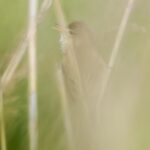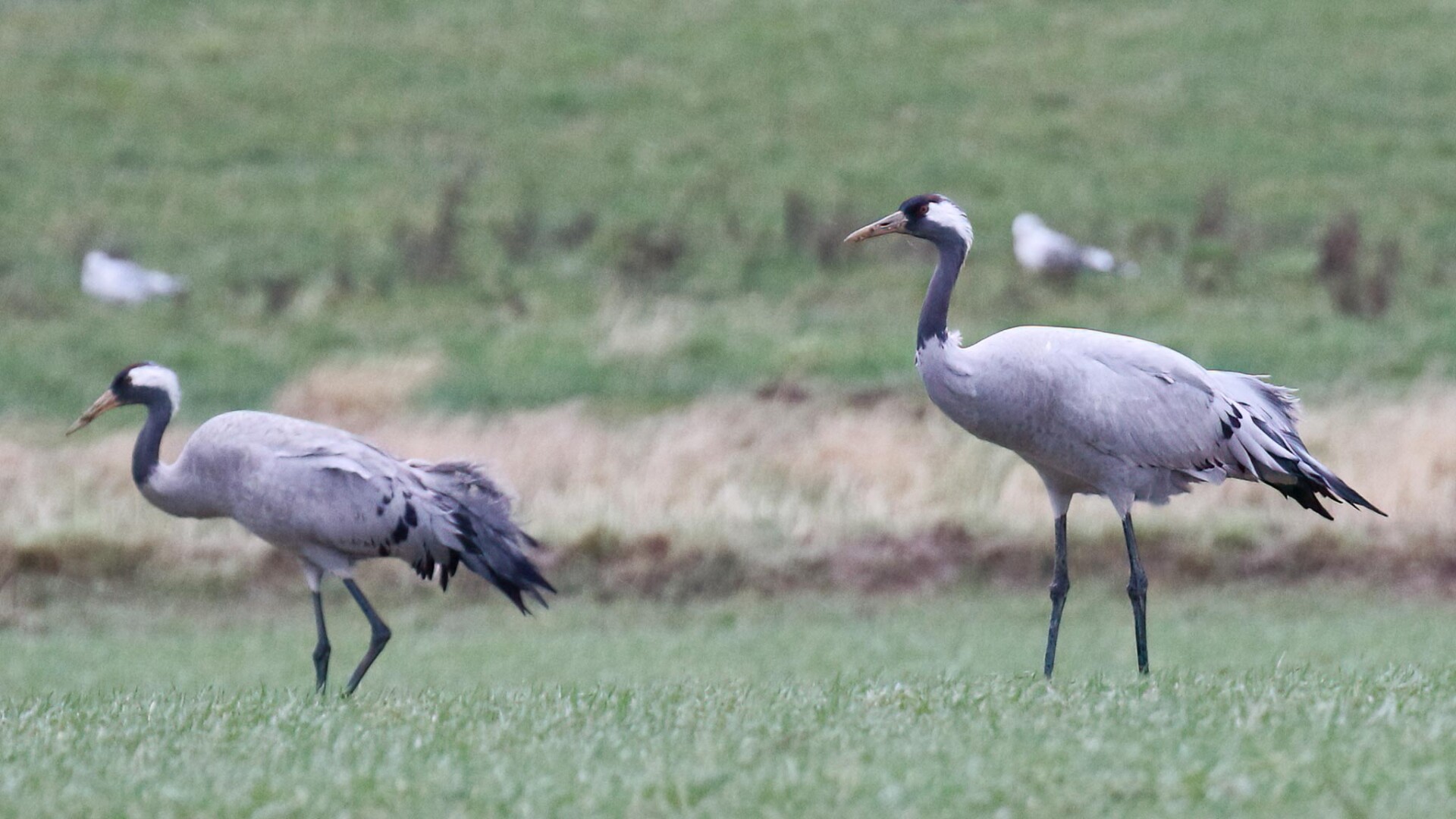An International Tour organised in conjunction with our friends at Oriole Birding, our regular spring visit to Extremadura timed to coincide with displaying bustards and freshly arriving summer migrants.
We hope to run this tour again in 2025, so if you like what you read, please get in touch. You can keep up to date with all our forthcoming International Tour dates here.
Friday 12th April
It was an early start – most of the group met at 4am at the EasyJet check-in at Gatwick North Terminal for our flight down to Madrid. The ground staff managed to get everyone on board the plane early and although we still left on time at 6am we arrived almost 40 minutes earlier than scheduled. Our bags were waiting for us on the carousel by the time we got through passport control and our first birds of the trip, House Sparrows and Feral Pigeons, were around the terminal building as we went out to the car park to pick up our minibus.
We were soon underway and as we got out of the urban sprawl, we started to see more birds – both Black and Red Kites, White Storks in the fields and on their nests, a few Common Swifts and Barn Swallows, and the ubiquitous Corn Buntings and Crested Larks.
As we approached Oropesa, where we would have our first break, we saw our first Eurasian Griffon Vultures thermaling up and from the car park at the service station we could see more circling in front of the snow-capped Gredos mountains along with two Black Vultures as well. Lots of Lesser Kestrels were flying round above the castle distantly behind us. There were Spotless Starlings, White Wagtails and more Crested Larks around the car park and a pale phase Booted Eagle landed on a fence post just beyond.
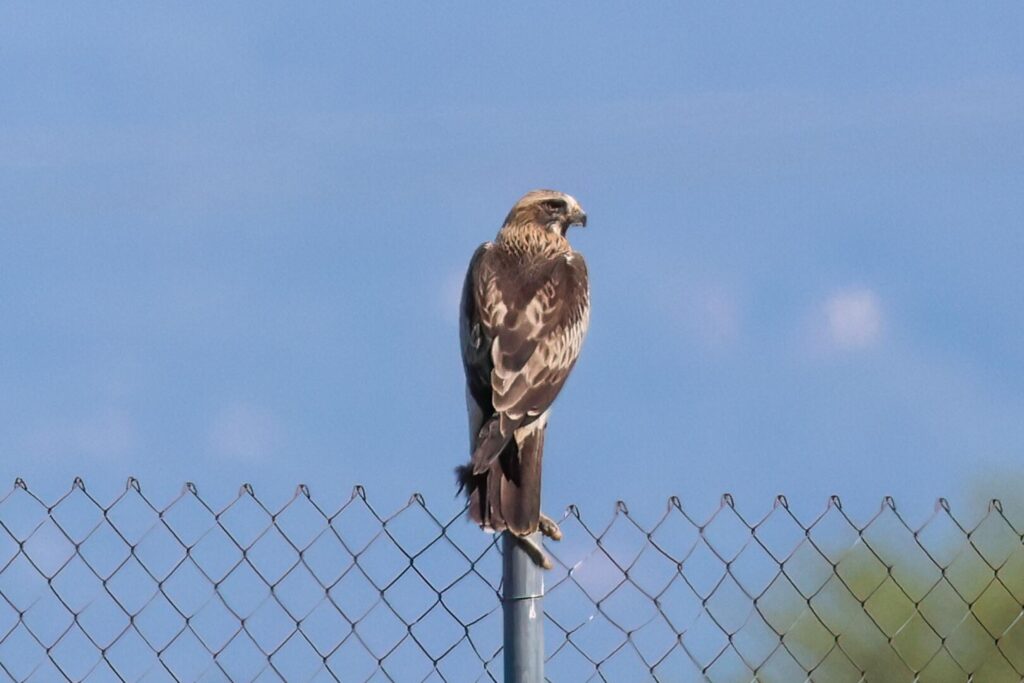
It was still early, so we took a drive along a local road out into an area of open fields. Just a short way down, a tractor was cultivating one of them and it was being followed by a mass of White Storks so we stopped to watch, counting at least 45 storks and several Black Kites too.
Further along, our first Bee-eaters were on the wires and as we got into the dehesa further down we found several Woodchat Shrikes and a couple of brief Iberian Magpies which flew away into the trees. A Whinchat perched on the top of a tree by the road was likely a migrant stopping off on its way north. With the windows down, there were lots of Common Nightingales and Chaffinches singing now and a couple of Serins flew along beside us. When we got out of the minibus again to photograph the view across to the mountains, a Common Cuckoo was calling from the trees.
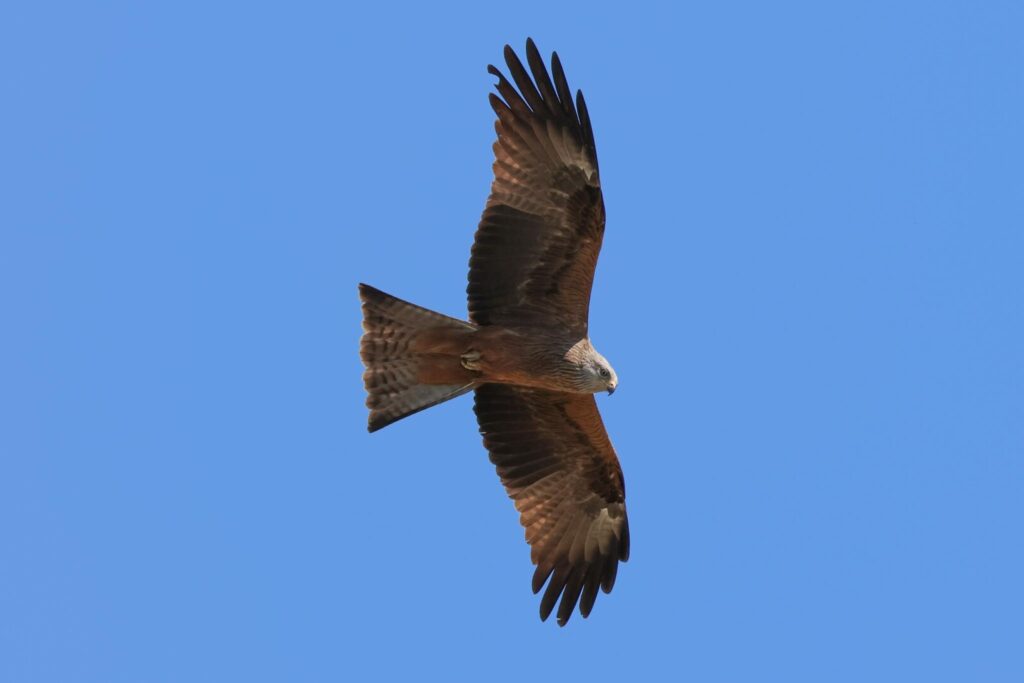
We turned round and headed back to the services, but spotted an Iberian Grey Shrike on the wires now and stopped for a closer look. It dropped down to the ground and caught something, then flew to a pile of branches where it looked like it was going to impale it, before flying up into a nearby dead tree where we realised there was a second Iberian Grey Shrike hidden in the branches.
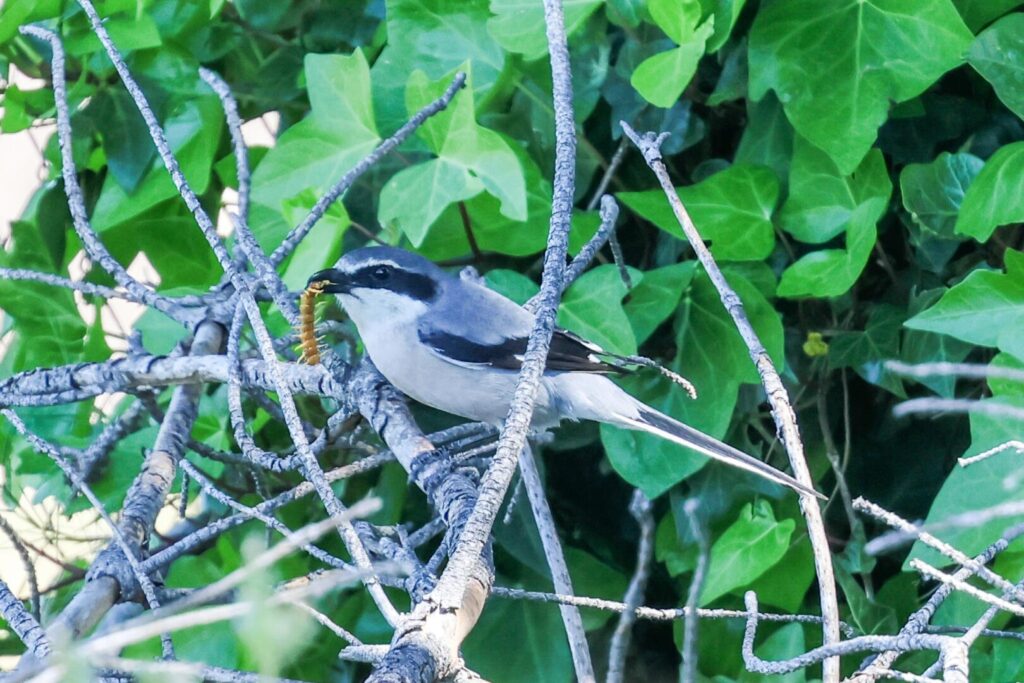
After a break for lunch at the service station, we drove back onto the motorway and continued on down as far as the town of Saucedilla where we stopped at the information centre for the Arrocampo nature reserve. It was the heat of the afternoon now and seemed rather quiet at first as we walked down to the nearby hide. Lots of Swallows were flying in and out from under the nearby bridge, with a Sand Martin on the wires and one or two House Martins too.
Several Purple Herons flew back and forth over the channel in front of the hide and occasionally landed where we could see them, a Reed Warbler was singing from the reeds and a Sedge Warbler flew in and several Cetti’s Warblers shouted at us from wherever they were hiding, a few Gull-billed Terns were hawking in the distance over the fields beyond the water and one or two Marsh Harriers quartered over the reeds.
From time to time we could hear a Purple Swamphen calling behind us so when we saw one fly up briefly we walked back to see if we could see it. Thankfully it showed itself now as it climbed through the dense rush clumps on the other side of the channel. A Lesser Emperor dragonfly was hawking up and down over the water.
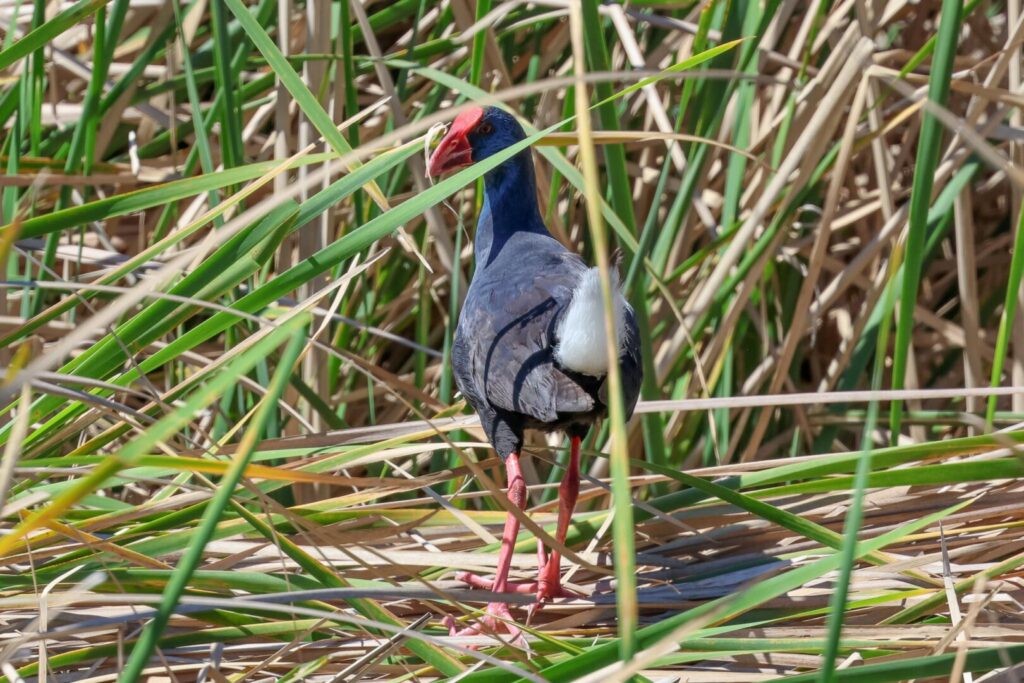
We continued on down long the track beyond the hide a short way, where two Stonechats were calling and flicking around in a mass of yellow flowers, looking particularly picturesque. A couple of Zitting Cisticolas flew round overhead singing as their name suggests and a couple of times one landed and continued singing where we could get a better look at it, even managing to get one in the scope at one point. A Corn Bunting singing from the wires nearby was worthy of a look through the scope too. As it was still quite hot, we decided to have a drive round to the far side of the reserve.
As we walked back to the minibus we stopped for another scan of the reeds and a Black-crowned Night Heron flew out and landed on the edge of the water. The pools the other side of the town are getting quite overgrown now, but further on we found several Cattle Egrets around a more open grassy pool, along with several Mallard. A White Stork was on its nest on top of the next hide but there was nothing on the water beyond and as we drove on to turn around, a Green Sandpiper flew up out of the ditch by the road.
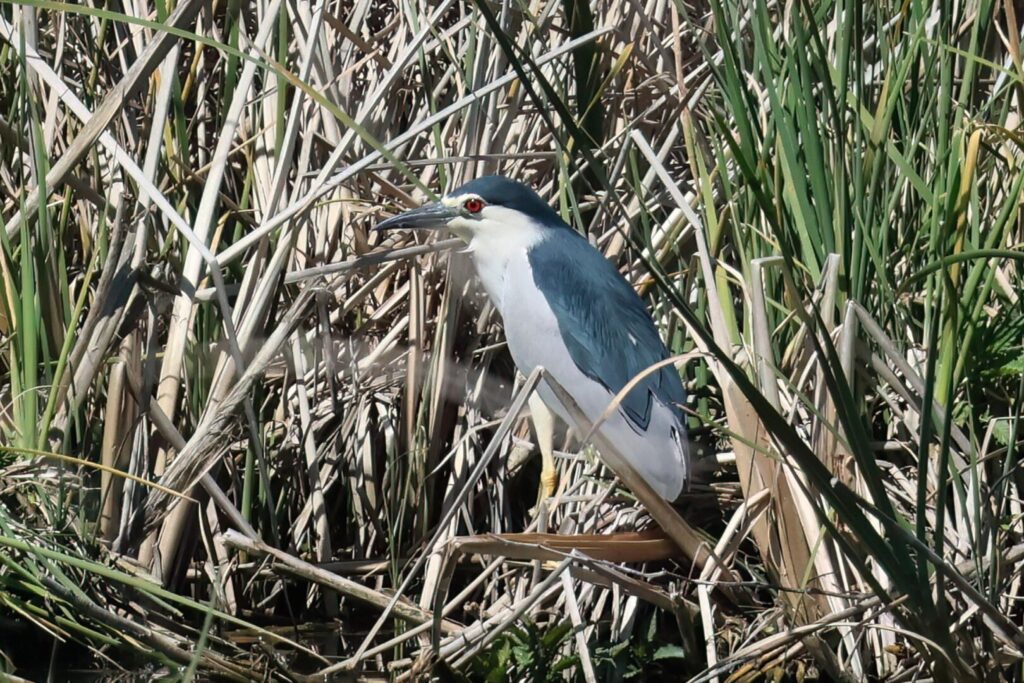
Heading back towards the motorway, we stopped again by another hide. There was nothing around the pool in front but we could see several birds when they flew up out of the reeds further back – a gathering of Great White and Little Egrets, Grey Herons and several Glossy Ibis. A Purple Heron and a single Spoonbill flew over. A couple of Savi’s Warblers reeled intermittently from the reeds but kept themselves hidden.
A quick check of the larger arm of the reservoir across the road produced more distant Cormorants and Gull-billed Terns which were hard to make out in the heat haze, and another Purple Swamphen on the edge of the reeds. Some nice Barbary Nut irises were in the grass in the layby, where there were still several puddles, a reminder of how much rain there had been earlier in the year.
As we set off again, we were watching a Black Vulture flying off ahead of us when one of the group spotted three vultures in a field close to the road. We pulled up and could see they were two Black Vultures and a single Griffon, the former picking at some bones in the grass. Great views before something spooked them and they flew further back.
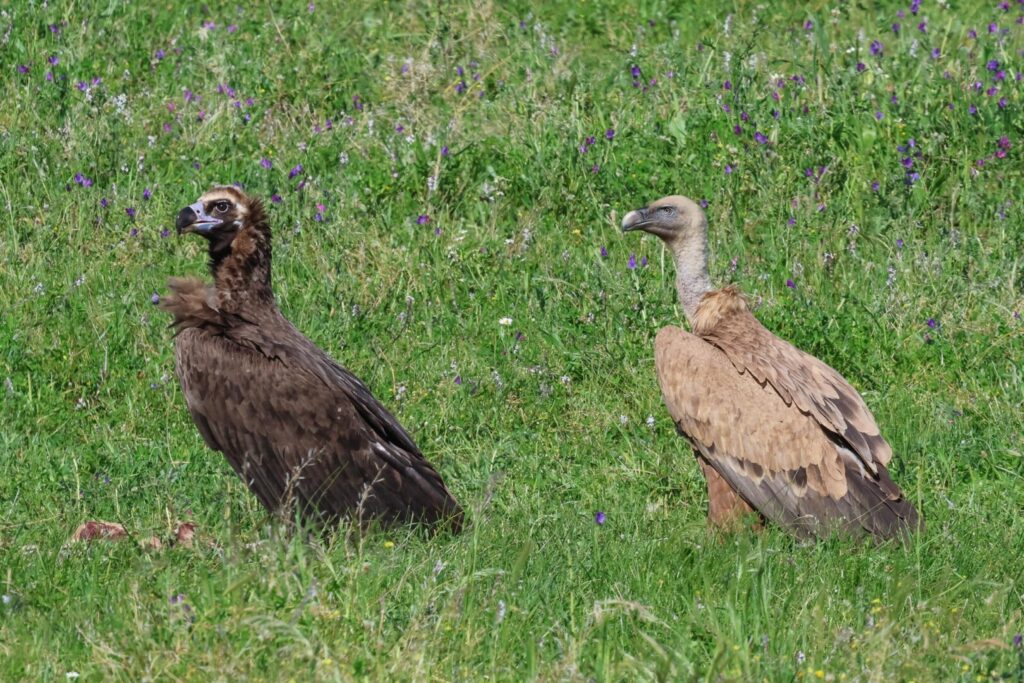
It was only about 45 minutes drive from here to Pago de San Clemente, just beyond Trujillo, where we would be staying at Casa Rural El Recuerdo for the next few nights. Claudia came out to meet us, along with the final member of the group who had driven down separately, as we got out of the minibus. It had been a long day so, after a break to settle in, we met for an early dinner, a delicious home-cooked Spanish meal of artichokes, followed by meatballs and then almond tart.
After sitting down to compile the day’s list, it was still light outside and a group of Iberian Magpies were calling from the bushes in the garden, with one being chased out by a Blackbird. A Serin was singing from the top of a tree and a Spotless Starling was mimicking various other species from the rooftop. Then it was time to turn in.
Saturday 13th April
After breakfast, while we were loading up the minibus, a Black Redstart was singing from the top of a tree above the driveway, perched next to a Blue Tit. The sun was just rising and it had been cooler overnight, so it took us a minute or so to demist the windscreen before we could negotiate the narrow roads through the village.
We drove through Trujillo and out along the old road to Caceres, where we pulled up briefly to look at a Short-toed Eagle on a pylon, then as we got out onto the open plains we stopped on a low ridge by the side of the road and got out. After a wet winter and more recent rains, we were immediately struck by how much taller than usual the grass is this year and how many flowers there were.
We could hear several Quail calling out in front of us. A pair of Crested Larks were feeding on the gravel and several Corn Buntings were singing all around. We could hear a Reed Warbler singing briefly down by a small pool and a Sedge Warbler then appeared in a bush in the parking area and started singing too, presumably migrants passing through. A Woodchat Shrike was perched in the top of one of the trees behind us and an Iberian Magpie flew through. One of the group shouted and we turned to see a Great Bustard flying towards us and past in front of us into the sun, followed shortly after by a second which came behind us a bit further away, a nice start.
Continuing on, we turned onto a drovers’ road out across the plain. Several Calandra Larks and Crested Larks came up from the side of the track, some perching obligingly on the fence posts for us to look at, and an Iberian Grey Shrike was perched on the next fenceline over.
We stopped in a gateway where we could pull off and got out again. The first thing which struck us was the sound – larks were singing all around, Calandra Larks fluttering high overhead, showing off their black underwings, and we marvelled at the complex mimicry woven into their songs, at times sounding like other birds like Green Sandpiper, Bee-eater or Kestrel.
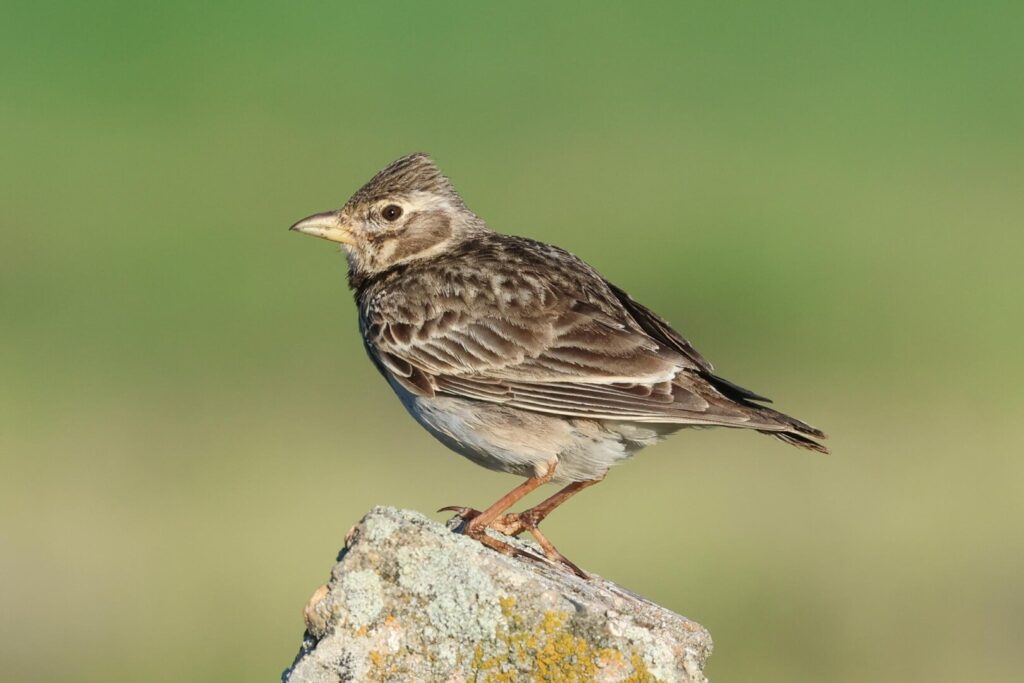
A Great Bustard was displaying out on the hillside, with its head pulled in, tail raised and wings out, if not quite the full ‘foam bath’, and another was on the top of the ridge beyond. We could hear a distant Little Bustard somewhere too but couldn’t tell whether it was hidden out in the tall grass or down in a dip in the field. We eventually got the scope on what was likely a second one, up towards the top of the slope, and could see the black and white pattern on its neck, which it threw back when it sang.
This can be a very good spot for sandgrouse, but they would be tricky to see in the taller vegetation this year – we heard some Pin-tailed Sandgrouse calling high in the sky but couldn’t see them into the sun. Some Dutch birders called over as they walked back to let us know that a Spanish Imperial Eagle was perched in the top of a large eucalyptus tree very distantly behind us further up and through the scopes we could see the golden shawl over its head and nape and white shoulders.
We drove a bit further along to see if we could get closer to the tree where the eagle was perched, losing sight of it behind a ridge at first but as the ground rose again we could see the tree once more. We stopped and got out and could see the Spanish Imperial Eagle through the scopes although it was back on from here, if a little closer.
A Marsh Harrier came up over the ridge ahead of us briefly. Continuing on up the next ridge, a pair of Northern Wheatears flicked along the track ahead of us and a pair of Thekla’s Lark flew up from the verge and landed on the fence where we could see their more sharply black-streaked breasts and shorter, deeper bill compared to the Crested Larks we had just seen.
We stopped at the top and got out to scan again. A pair of Black-winged Stilts flew across out over the fields and then we picked up three distant Black-bellied Sandgrouse followed by another pair a little closer, which flew towards us before turning and eventually dropping out of view in the distance further ahead. As well as the grass being taller this year, the flowers have come out in profusion and the plains are carpeted in colour, washes of purples and yellows. Several Western Dappled White butterflies were fluttering around the flowers by the side of the track.
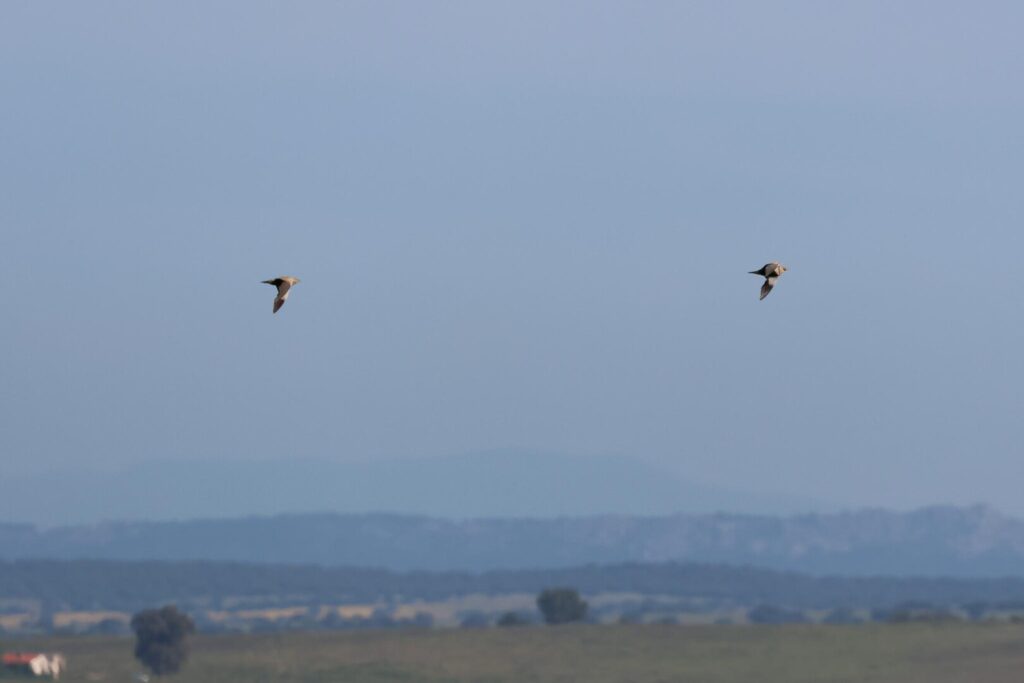
We decided to head back to where we had stopped earlier and have another listen for Pin-tailed Sandgrouse. A couple of Short-toed Larks were on the track ahead of us now before they flew off. We hadn’t been long out of the minibus, when we heard Pin-tailed Sandgrouse calling but just had a brief glimpse as one dropped over the back of a field full of cattle. Then shortly after we heard some more and this time managed to pick them up flying in towards us, three of them. Unfortunately they turned and headed away again before they got to us. A start at least and we could try for closer views later. It was getting hotter now and activity out on the open plains was starting to drop off so we decided to move on.
We drove on and into the more rocky wooded hills, and where the road dropped down to a bridge over the river Magasca we stopped again. There were several Crag Martins and Red-rumped Swallows swooping in and out under the bridge and we spent some time watching the Crag Martins dropping down onto the riverbank below to collect mud, one from time to time landing on one of the rocky faces by the road or under the bridge.
There were lots of Serins, Chaffinches and Spanish Sparrows in and out of the bushes and a Cirl Bunting which sang briefly from the trees behind us before flying of over our heads and off to the top of the ridge the other side. A couple of the group saw a Kingfisher shoot off upstream and a Grey Wagtail flew over and dropped down on the bank further up. We could hear Bee-eaters calling and at one point several flew past us and landed in a dead tree above the river a short way downstream, where we could get them in the scopes.
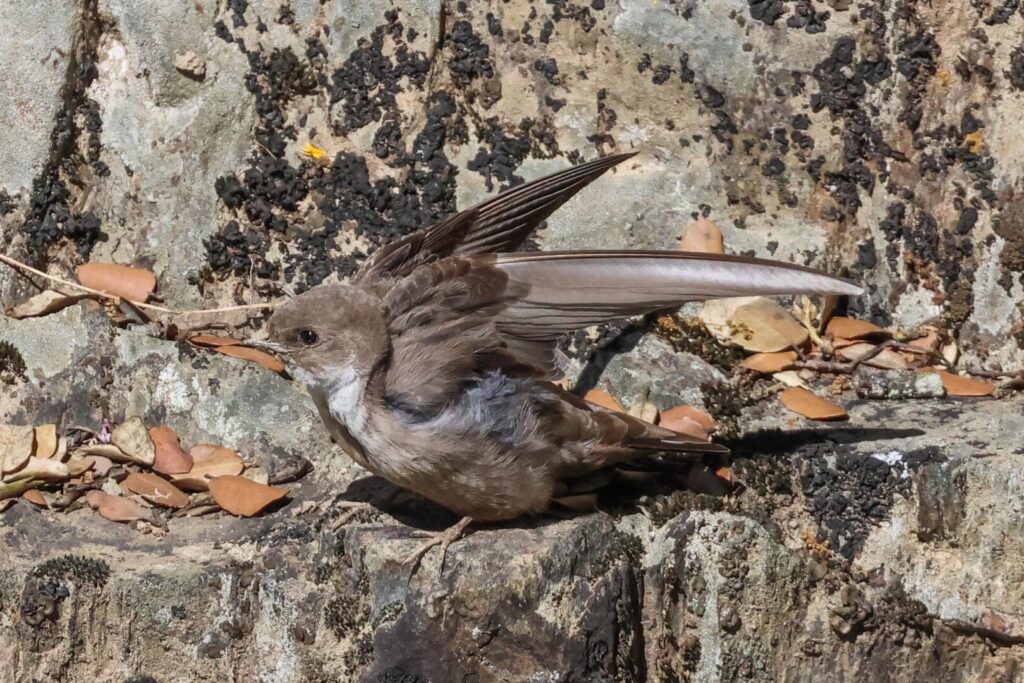
Driving on, we came back out onto the plains. We stopped to scan and heard another Quail calling and could see several kettles of vultures circling up in the warm air now. One group of Griffon Vultures drifted in towards us losing height and started to circle up again right above our heads before gliding away in the direction of another kettle further up. It was time for lunch, so we headed back round to another river crossing but were disappointed at first to find a car blocking our favoured parking spot so we had to drive further up the road beyond and stop in another layby.
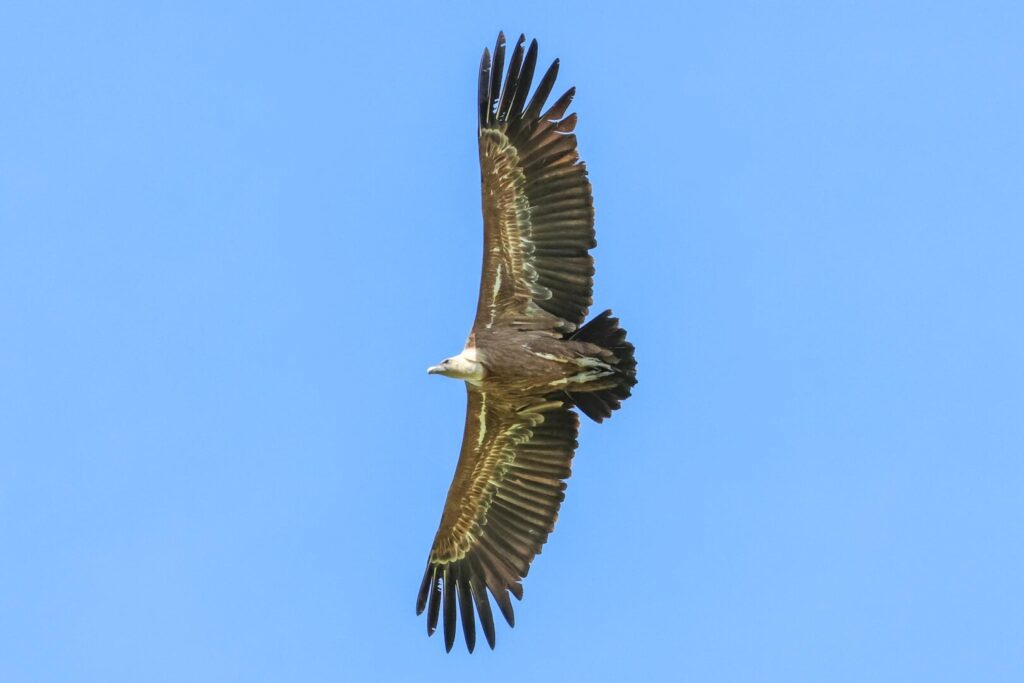
As we got out of the minibus, two Short-toed Eagles were circling up above us, a couple of Nightingales were singing in the bushes, and more Serins were in and out of the trees. While we were eating our sandwiches, one of the group spotted another raptor come low over the trees behind us and we turned to see a Spanish Imperial Eagle flying past. It stopped and started to circle, giving us some great views, drifting off, then coming back and circling closer to us again before gaining height and flying away – we were now actually quite pleased that we had been unable to park at our first choice of lunching location today!
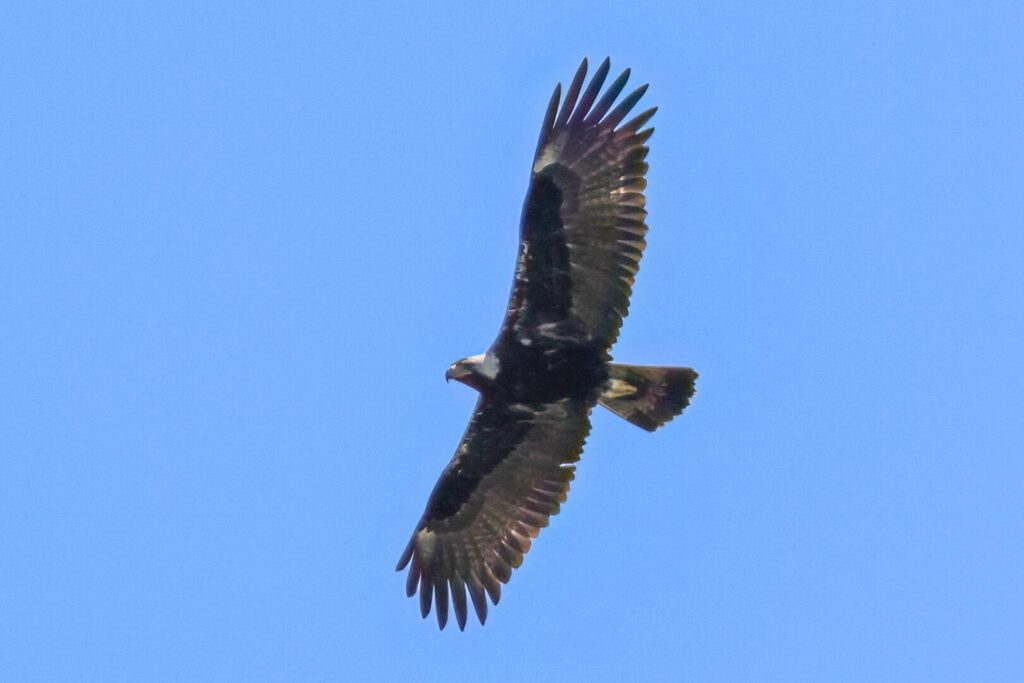
After lunch we moved on and out across the steppes again where the telegraph poles beside the road each had a large box attached, Roller nest boxes. The first just had Jackdaws which had taken ownership but we didn’t have to go far before we found our first Roller, so we stopped to look at it perched on the wires, the first of several along this stretch. Then we continued on to a nearby filling station to refuel, stock up on bottles of cold water and have a short break for a coffee, cold drink or ice cream. A couple of Black Kites were in and out of the trees on the forecourt.
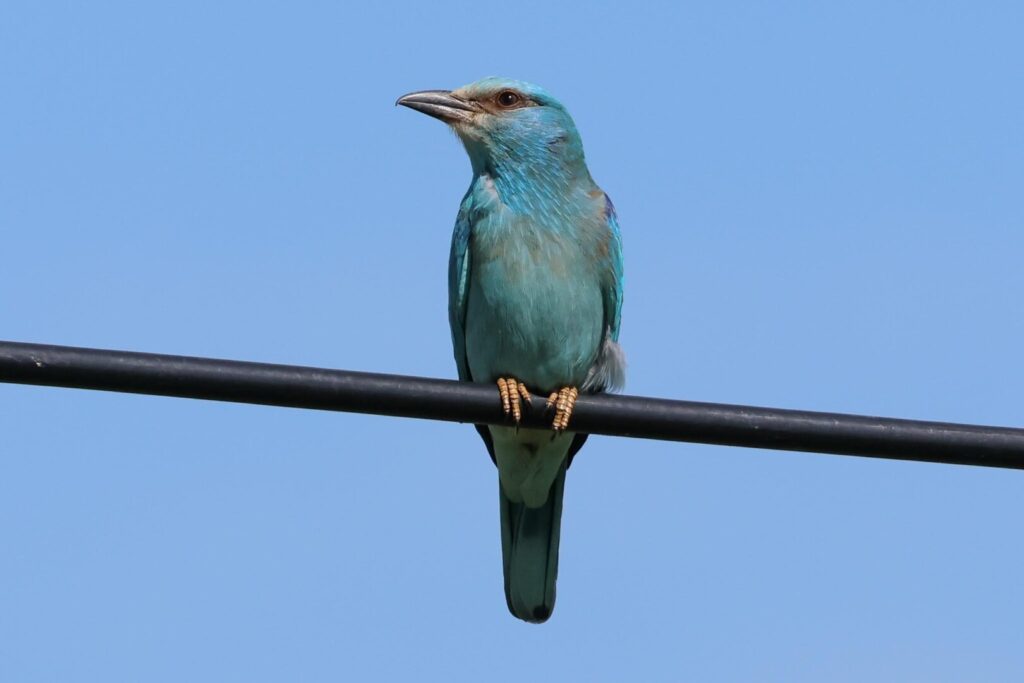
Heading back out onto the plains afterwards, we came to some fields which had been cultivated earlier in the year, where the vegetation was much shorter and sparser. We stopped to scan and found several Great Bustards, two singles and then a group of three further along. There were more Short-toed Larks singing here and we managed to get one in the scope feeding in and out of the furrows and clods of dry earth. A pale phase Booted Eagle flew past.
Further on, we turned onto another drovers’ road and stopped again. There were two more Great Bustards in a grassy field, which settled themselves down out of sight, a Marsh Harrier was quartering further up and then a male Montagu’s Harrier appeared, flying over the back of the field in front, silvery grey with black wingtips and very slim winged.
We drove on to see if we might be able to meet it again further up, but now we found a female Montagu’s Harrier working the verges either side of the road, heading straight towards us. We stopped quickly and got out and had some great views of it before it saw us ahead, turned and circled up high before drifting away. A Lesser Kestrel circled up here too.
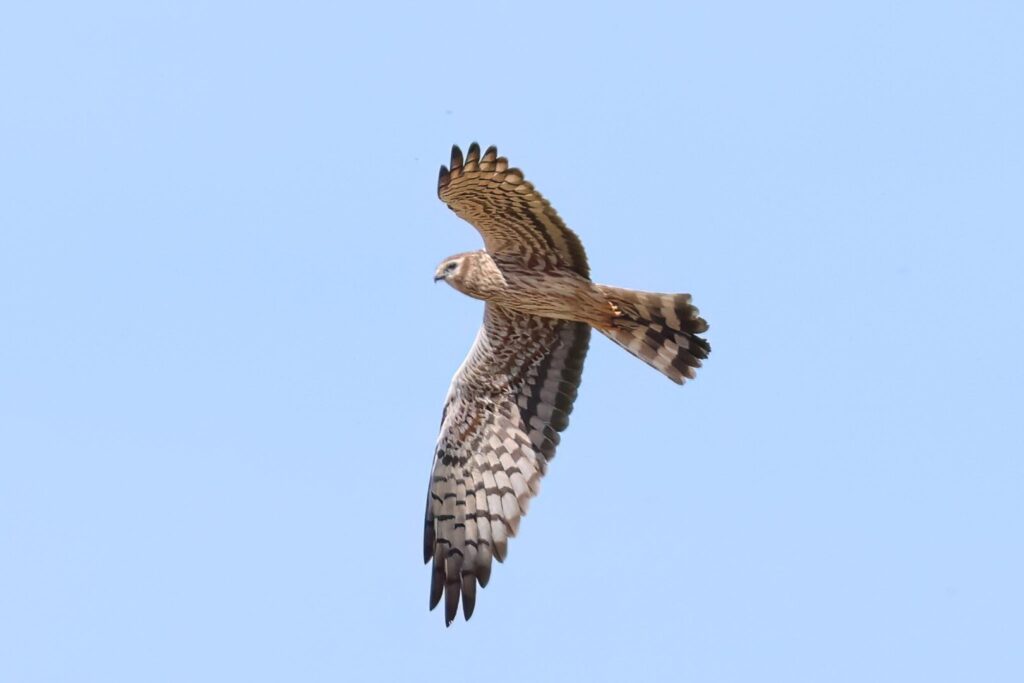
Continuing on, there were a couple more Short-toed Larks dustbathing on the track ahead of us, and the usual seemingly endless succession of Calandra Larks, Crested Larks and Corn Buntings. We were struck again by the colours of the wild flowers in the fields here too, huge swathes of purple and yellow carpeting the landscape. Amazing to see the amount of life here, even in the heat of the afternoon, a noticeable contrast to the much more barren agricultural landscape we are familiar with back home. We came to some farm buildings where several more Lesser Kestrels were flying in and out of the roof, but they drifted off out over the fields as we pulled up nearby.
We drove back round, stopping on the way to look at a couple of Woodchat Shrikes on the fences by the road and a pair of Hoopoes, one perched in a tree and the other down in the grass below.
When we got to the bridge where we hadn’t been able to stop for lunch, the parking place was free now so we pulled in for a quick scan. More Crag Martins were swooping round low over our heads and into the bridge below and once again there were lots of Serins flying round calling. What was presumably the same Spanish Imperial Eagle we had seen earlier appeared again, circling high overhead now. A White Wagtail flew past, but we couldn’t see anything else down along the riverbanks.
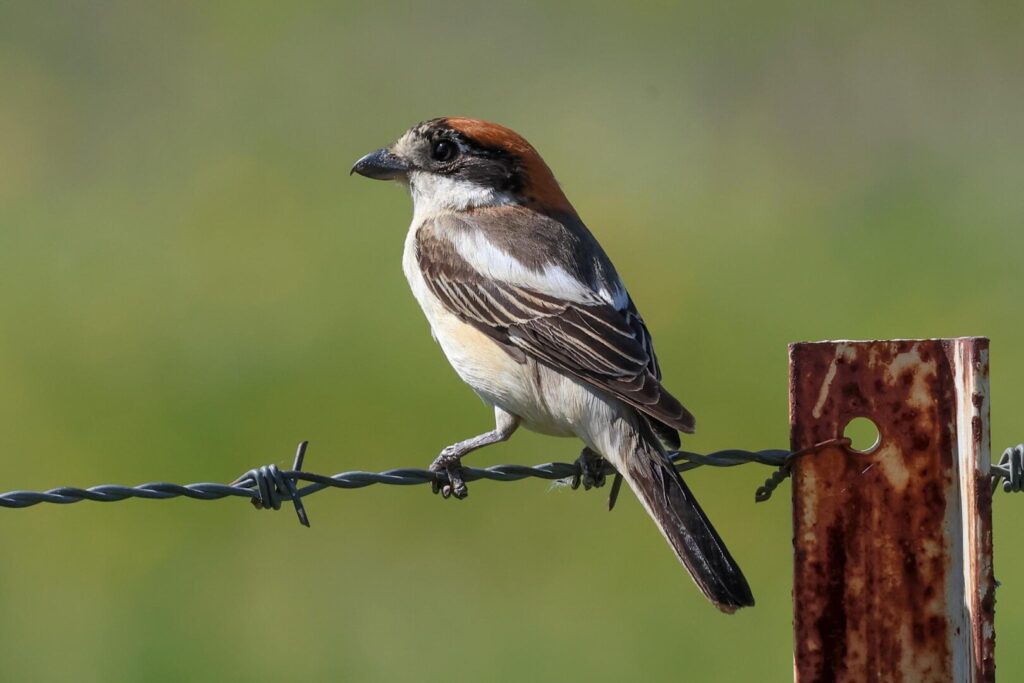
We had hoped it might start to cool down and we might go for a walk down through some fields in a more agricultural area but it had continued to get hotter through the afternoon. As we drove on up towards Monroy now, it seemed rather quiet apart from the larks and Corn Bunting sheltering in the shade of the bushes by the road and a couple of Red-legged Partridges which ran out from the verge.
Then one of the group shouted and we had to make a quick stop as a Great Bustard was standing on the low earth bank of a small farm reservoir right next to the road. We pulled up alongside and had stunning views of it as it stood panting and then walked slowly along the top of the dam. Eventually, it flew and landed again in the vegetation much further back. Wow!
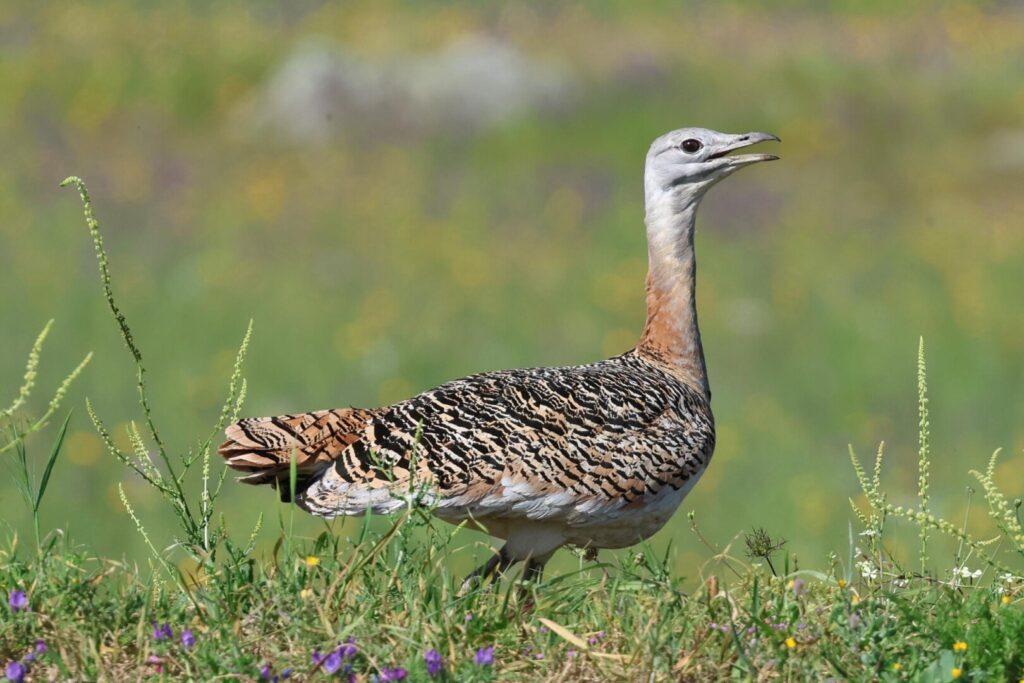
When we got to Monroy, it was still very hot and we didn’t have much time left now, so we decided to head straight back. Cutting across country through the open dehesa, there were lots of Woodchat Shrikes on the wires at first and then where it was more open we saw several more Iberian Grey Shrikes. We got back to Pago de San Clemente with time to spare for a break and a shower to freshen up before dinner.
Sunday 14th April
This morning, we headed south through Zorita, pulling up in the minibus briefly to admire two Black Vultures standing in a grassy field close to the road in the early morning light before they lumbered into the air and across behind us and down into the fields the other side. There were several Black Kites and one or two Common Buzzards on the telegraph posts further along.
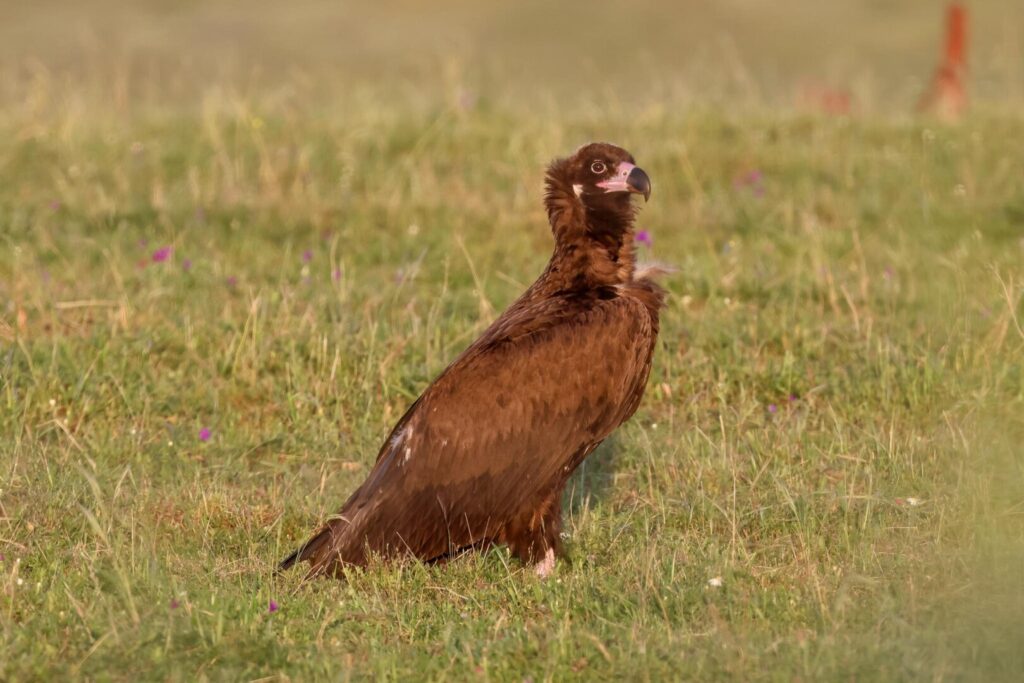
We turned off onto the minor road to Campo Lugar and quickly picked up a Great Bustard in a field full of purple flowers so we stopped and got out. The Great Bustard was a male, displaying with head back and tail fanned, and then we noticed there was a second displaying male nearby. The latter walked slowly off as a small flock of sheep approached, past the first which didn’t seem overly concerned.
A little further on, we stopped again to scan some closely grazed fields and picked up a Merlin perched on a small rock. We got out and set the scope up but before we could get everyone onto it, it flew off over the ridge beyond. There were lots of Calandra Larks singing here and a couple of Short-toed Larks too and in the next field back we found a single male Black-bellied Sandgrouse on the ground so we got the scope on that and had a good view of it in the shorter grass.
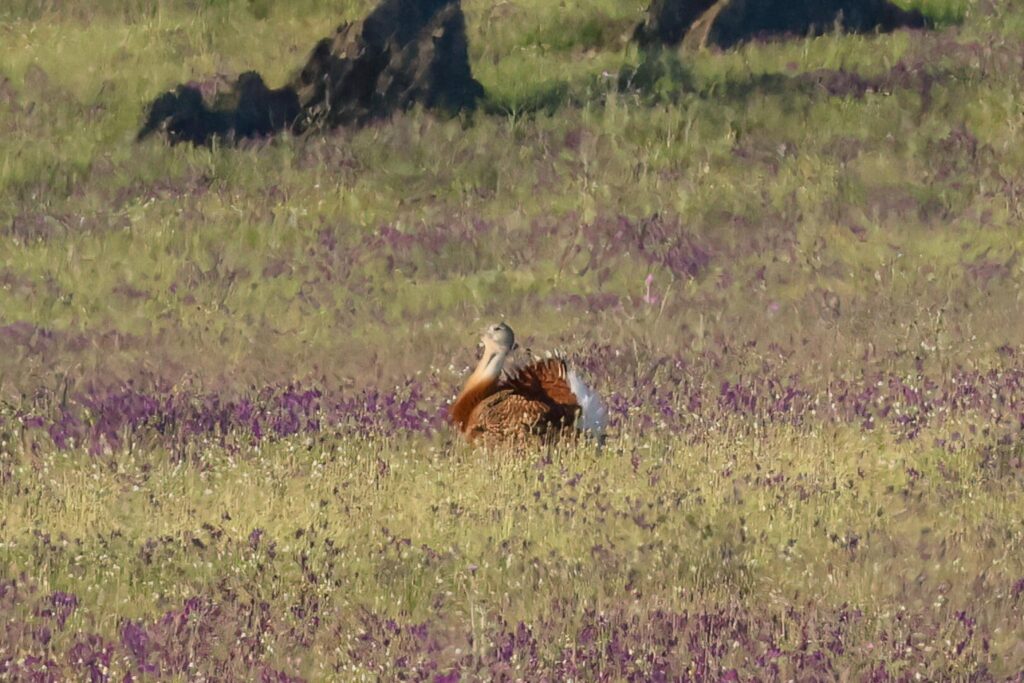
Continuing on, we stopped again in a gateway where we could pull off the road. A Quail and a Hoopoe were calling behind us and the latter flew up onto a tall pipe silhouetted against the sky. A Thekla’s Lark flew in and landed on a post next to the road right in front of us. A couple of Bee-eaters were hawking from the fence in front of a small pool, looking stunning in the early sunshine, and a female Northern Wheatear appeared on one of the fence posts next to them. Scanning the wires further back, we found a couple of Rollers and then a Short-toed Eagle on one of the pylons. As we got the scope on the eagle, an Egyptian Vulture appeared on a rock in front of it, the two of them in the same view together.
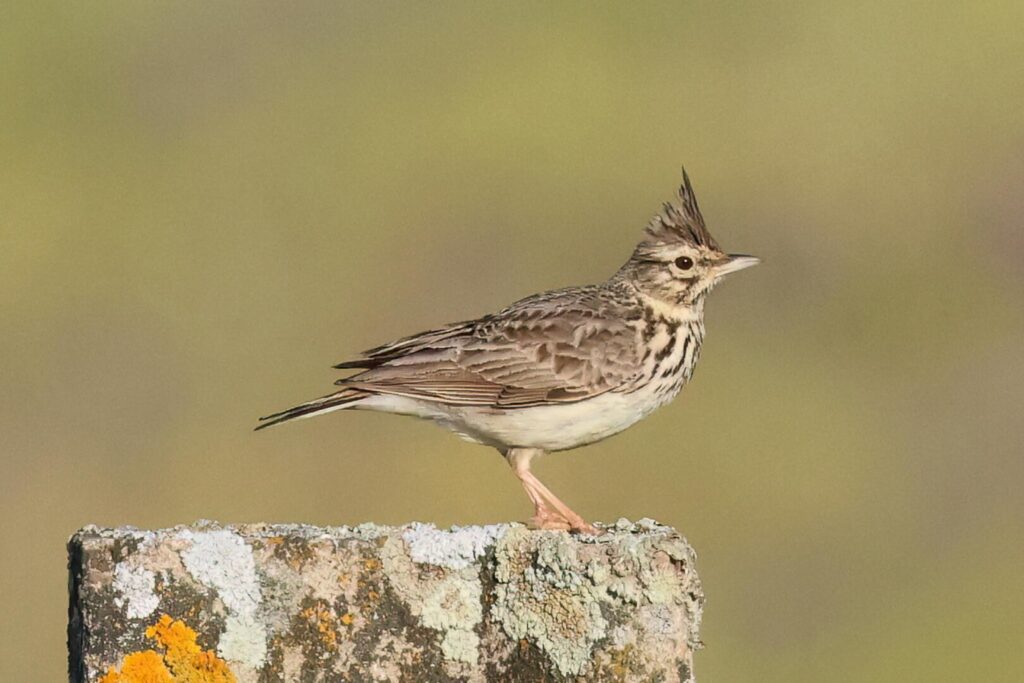
We drove on a little further to try to get closer views of the vulture, but as we pulled up it took off and flew away across the fields. A Roller was flying around in front of the slope beyond, its bright turquoise wings flashing in the sunshine. As we drove on further, a Stone Curlew flew up from one of the fields. Dropping down towards the village at the far end of the road, first a more distant Great Bustard flew across and landed out in a field below us and then a second one flew across the road in front of us.
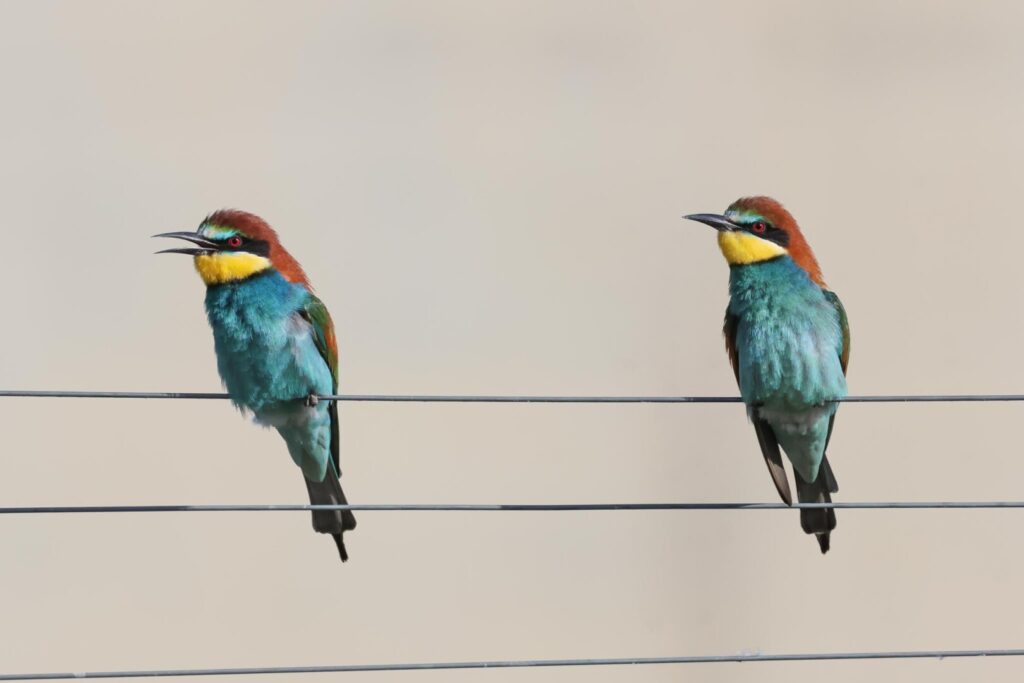
Our next destination was the Embalse de Alcollarin, and as we drove out beyond the village there were several Grey Herons in and out of the trees and a Marsh Harrier quartering the fields. Driving up the service road to the dam, there were lots of Bee-eaters posing obligingly on the wires and landing on the tarmac, so we stopped for a photo shoot, opening the doors and using the minibus as a mobile hide. A party of Iberian Magpies flew in through the olive trees behind and a couple of them landed on the fence in with the Bee-eaters at one point. A Booted Eagle circled up in front of the dam, where it was mobbed by Lesser Ketrels.
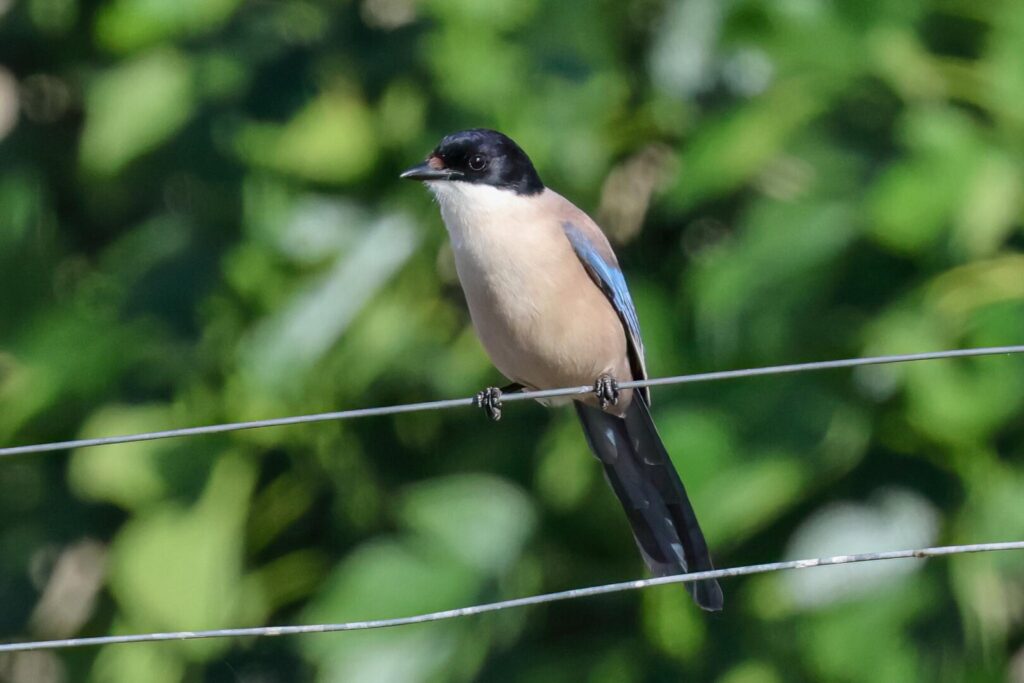
From the parking area at the top by the dam, we could see that the reservoir is very full this year, after all the rain over the winter. As we walked up to the fence a Common Sandpiper flew off round the edge below us as we set up the scopes to scan the water. We could see lots of Great Crested Grebes and we picked up a few lingering wildfowl over the far shore too – a single drake Shoveler and a couple of Wigeon, along with a few Gadwall and Common Coot.
Four Great White Egrets were perched in the low trees on one of the islands with a Grey Heron and a Little Egret for company and a pair of Egyptian Geese were down in the yellow flowers below. There were several Cormorants perched on some posts out in the middle and six first summer Yellow-legged Gulls flew in and landed on the water nearby.
We could see the Lesser Kestrels flying in and out from the face of the dam so we walked out to the middle for a closer look, stopping first to look the party of Iberian Magpies in the olive trees, a couple of which were hopping around on the ground below us. The Lesser Kestrels put on a great show, the males displaying, several of them carrying food which from photos we could see were all mole crickets. Looking down on them from the dam, we could see the distinctive grey panel in the wing coverts of the males. There were a couple of Common Swifts and Red-rumped Swallows here too, the Booted Eagle drifted back in and a flock of around a dozen Ravens flew past.
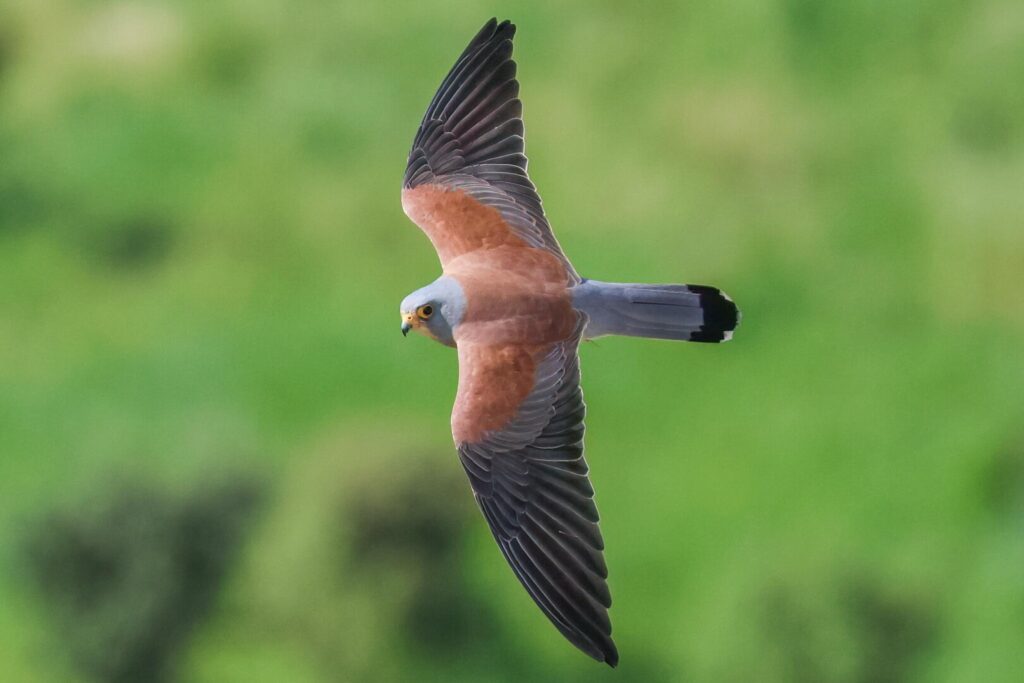
Back to the minibus, we drove round on the road which skirts the reservoir and stopped again where it nears the shore. There were more egrets on the island here, including a couple of Cattle Egrets, and a single Greylag Goose, a party of six Spoonbills flew past and five Common Redshank flew off in the other direction. We drove on to the picnic area and as we got out another Booted Eagle circled up low overhead.
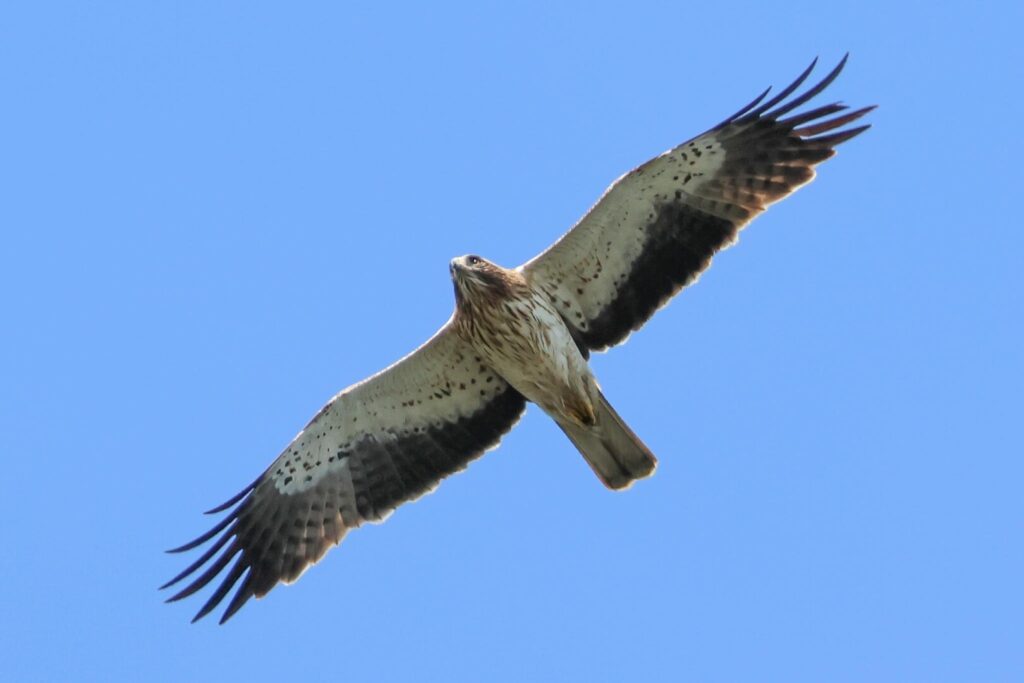
Walking out onto the small dam, two more Egyptian Geese were sleeping on the top and just beyond them two Gull-billed Terns were perched. We got them in the scope and had a very good view of their distinctive short, deep, black bills. A couple of White Wagtails and a Common Sandpiper flew off from the weir, two Moorhens were further along the water’s edge, a couple of Nightingales were singing behind us and the White Storks were bill-clapping on their nests in the dead trees.
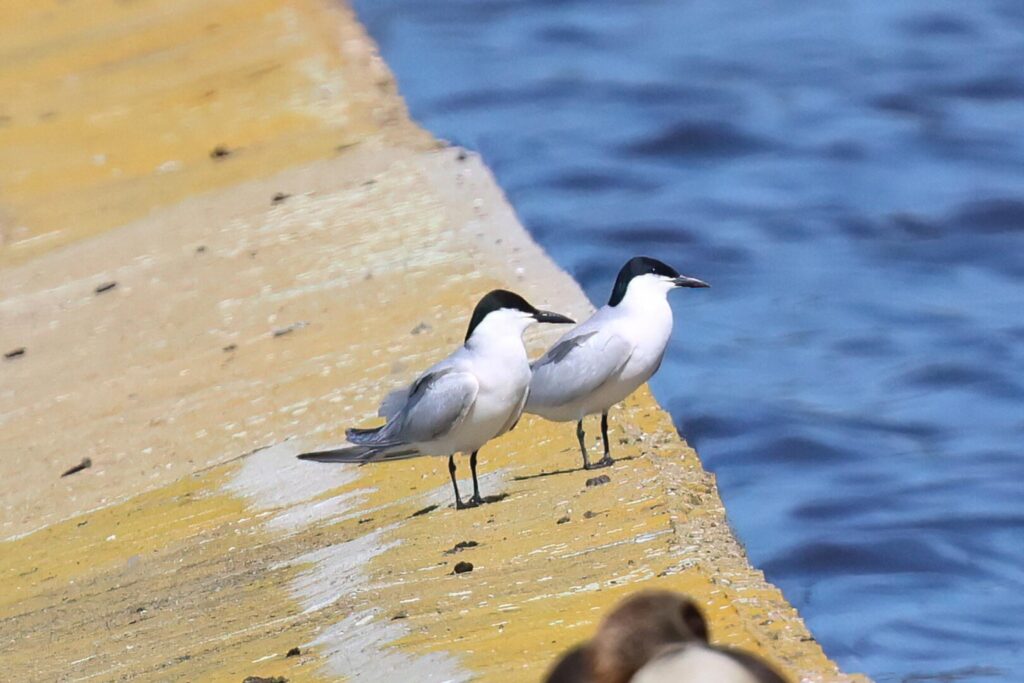
Scanning the hillside beyond, there were more raptors up, several Black Kites, and then we picked up an adult Bonelli’s Eagle which was joined by a second. We watched them circling up and could see alternately the white patch on their backs and their white body contrasting with their very dark underwings. Looking out across the water, another raptor flew in towards us, this time an Osprey, presumably on its way north it circled briefly and then continued on over the fields beyond. There were a few dragonflies around the vegetation at the side of the reservoir too, a Blue Emperor, a couple of Lesser Emperors and a few Red-veined Darters.
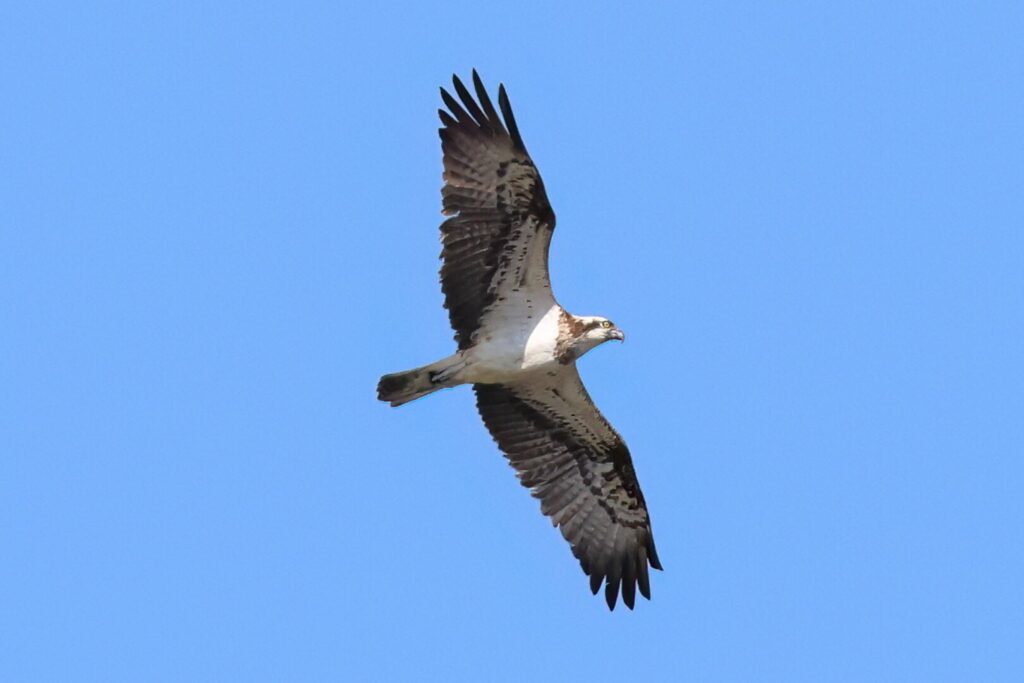
The picnic tables in the shade of the trees were empty, so we decided to take an early lunch break, it being Sunday and with the possibility they could quickly get busy. As we sat and ate, a Woodchat Shrike flew in to the tree above the minibus and dropped down to catch a large grasshopper on the ground, a pair of Sardinian Warblers flew into the oak above our heads along with a very smart male Spanish Sparrow which seemed to like this tree particularly as it kept returning there calling. There were a few butterflies around the flowers, most of which wouldn’t land but a Small Copper did briefly.
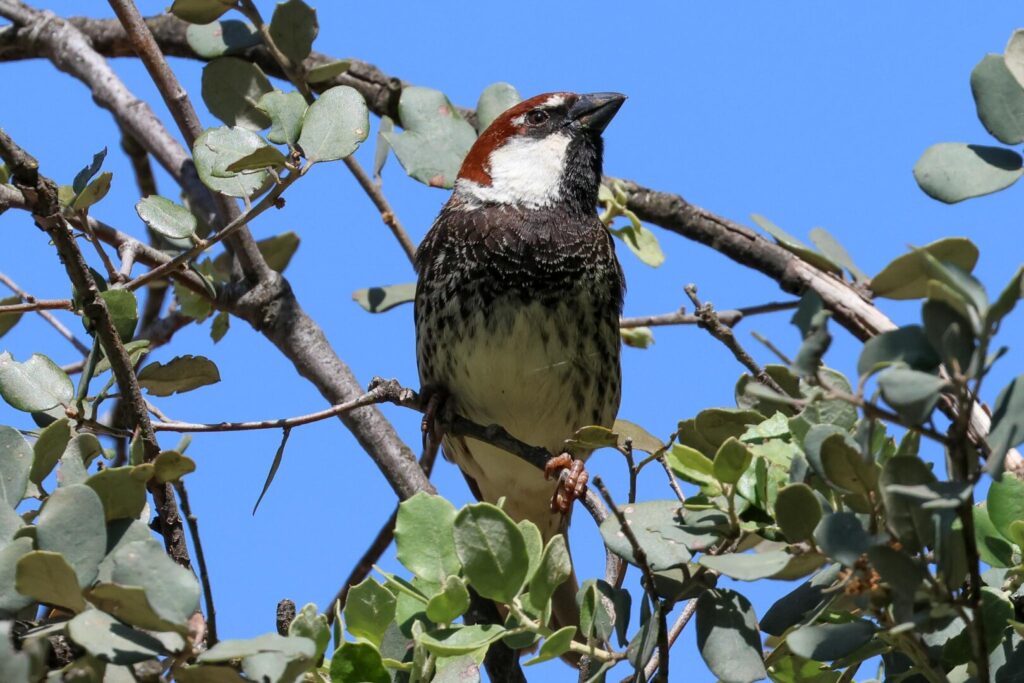
After lunch, we had a drive on around the north end of the reservoir. There were lots more Bee-eaters here, some excavating nest holes in the banks, and good numbers of Woodchat Shrikes. A Red-legged Partridge walked along the track ahead of us before sneaking round behind a bush and coming back out behind us. There was no further sign of the Bonelli’s Eagles now, but the Booted Eagle was still patrolling over the hills.
We decided to move on and drove back round the way we had come, past the dam. We took the minor road across to Campo Lugar this time, stopping first when an Egyptian Mongoose ran across the road in front of us, then to look at two Iberian Yellow Wagtails which flew up and landed again in a weedy field.
We were heading over to the reservoir at Santa Brava and cut back up and over the steppes – in the heat of the afternoon, there was much less activity now. From the dam the other side, we could see a few Gull-billed Terns out over the water and a single Black-headed Gull and following the service road beyond we stopped briefly for an obliging Iberian Grey Shrike in the bushes across the canal.
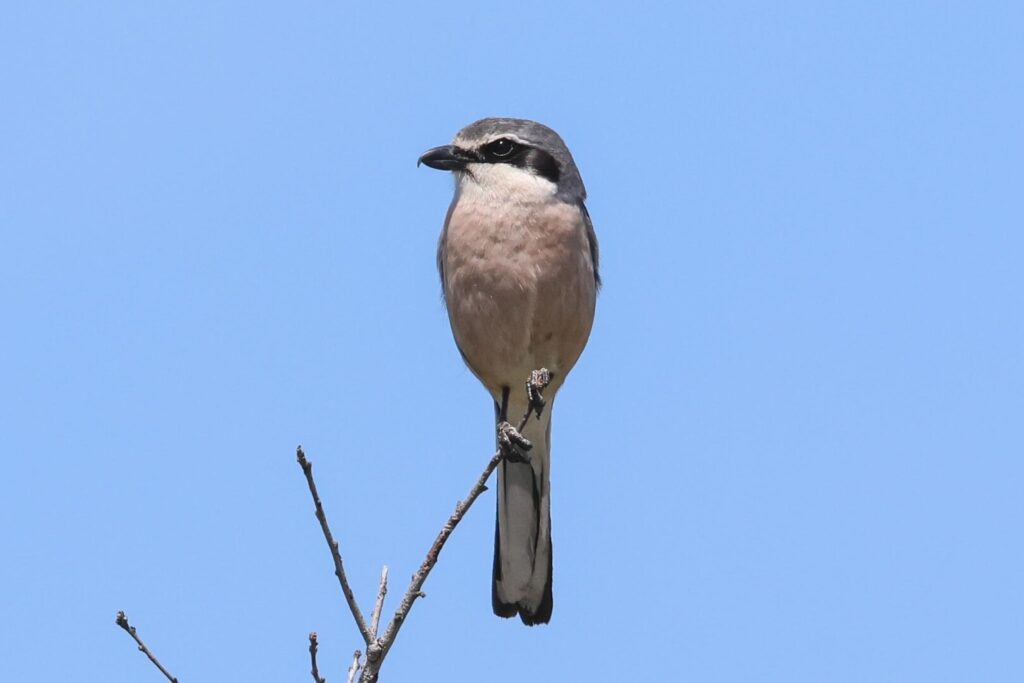
Cutting across into the ricefields, there was a lot of nice wet mud still but surprisingly few waders taking advantage of it. All we could find here were five Common Redshanks, maybe even the same five we had seen over at Alcollarin earlier! There were lots of Yellow Wagtails here of a variety of different subspecies, all with different head colours and patterns – as well as more good views of Iberian Wagtail, we found several Blue-headed Wagtails and a single yellow-headed British Yellow Wagtail, birds stopping off to feed on their migration north.
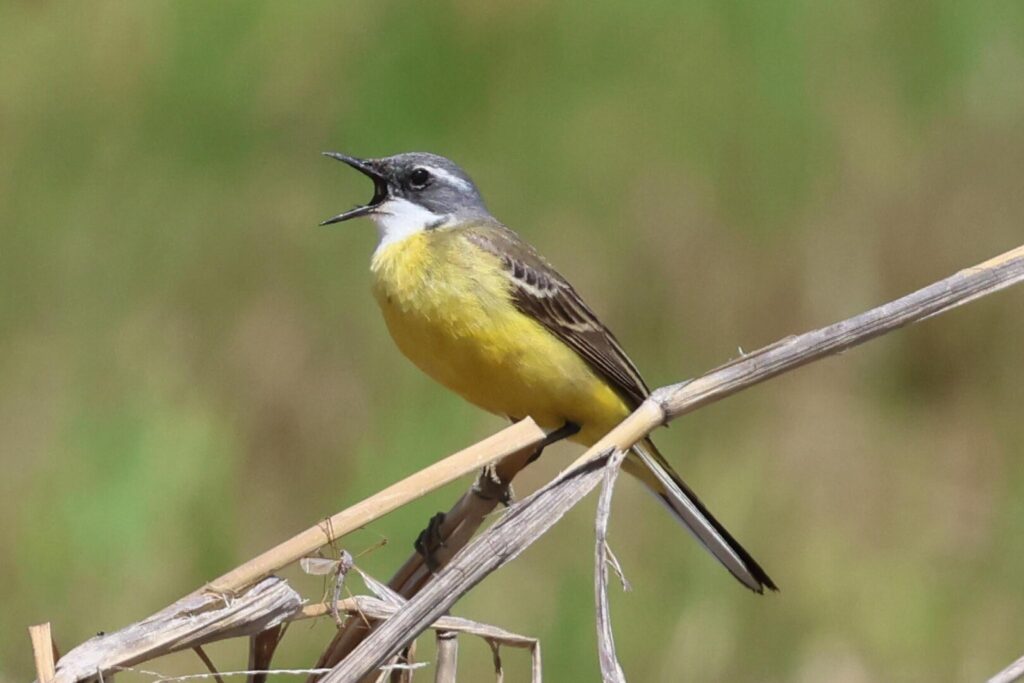
We drove on out of the ricefields and headed over to an area of open grass and trees where we pulled up by the side of the road and set up the scope. A Black-winged Kite was on its nest in one of the trees and we could see its head and shoulders above the rim and its bright red eyes. There was no sign of its partner though and not much activity in the middle of the day. A male Sardinian Warbler showed well in the brambles right by the road, a Quail was calling out in the grass and a pair of Iberian Grey Shrikes were in a nearby dead tree.
We decided to try another area of ricefields further on, but it was a similar story here, a nice mix of mud, rice stubble and bare cultivated fields, but not much in them – it seems like the waders have been taking advantage of the recent good weather to press on north and not stop. We headed back round to Madrigalejo and thought we might try across through Vegas Altas as our last stop but as we drove through town we heard a Great Reed Warbler singing from the channel below the bridge, so we found somewhere to park and walked back to see if we could see it.
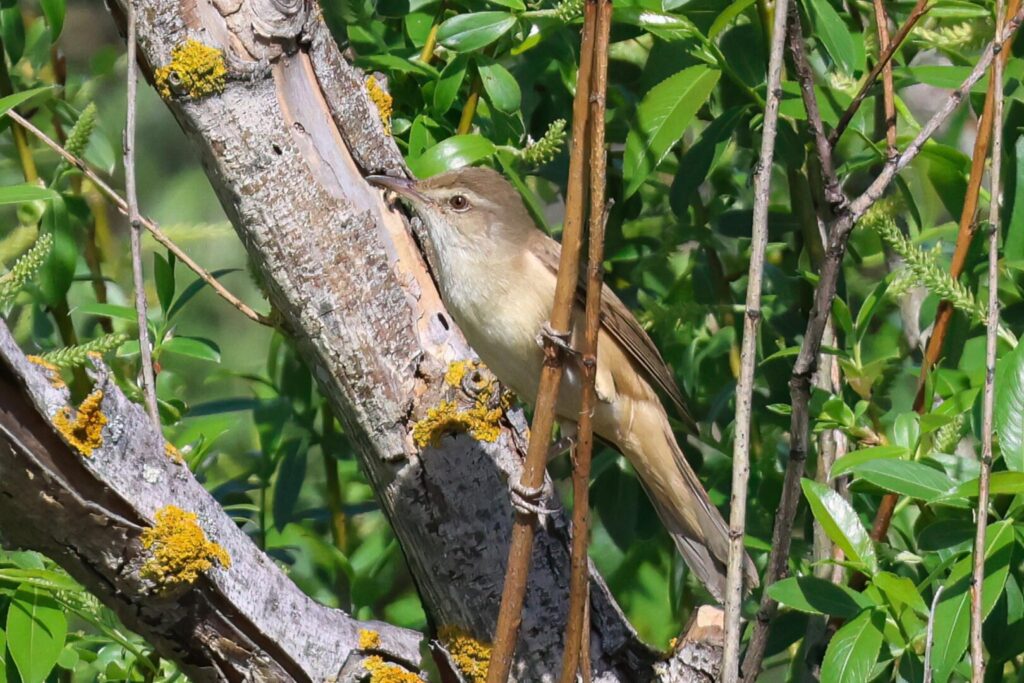
We could hear two singing from here, one of them right below us now but couldn’t see it at first. As we scanned the reeds, first a juvenile Red Avadavat flew in and landed below us and then a pair of Common Waxbills flew in as well but they came up and over the bridge past us and continued on along the channel the other side of the road. We had a couple of glimpses of the Great Reed Warbler down in the reeds but after a while it flew up into one of the willows above and we had a much better look at it now as it clambered around in the branches and then came out onto the front edge to sing in full view. As we walked back to the minibus, a Nightingale singing from the bushes was typically much less obliging and wouldn’t show itself.
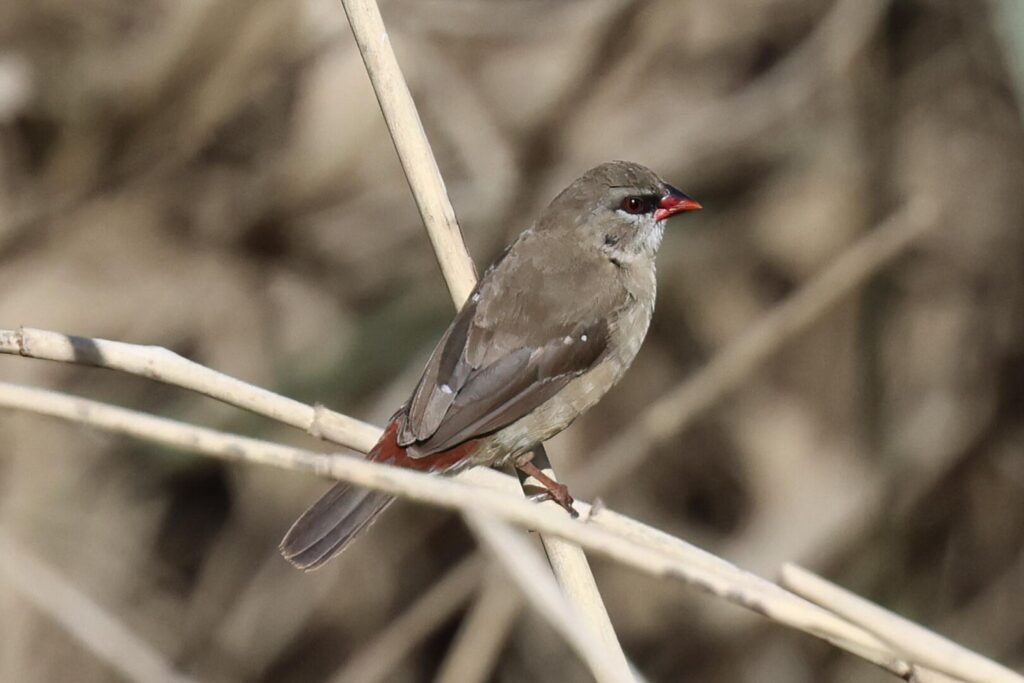
We didn’t really have time to head further down into the ricefields now, but as it was late afternoon we thought it might be worth having another quick look back in at the Black-winged Kite to see if there was any more activity. As we pulled up, as could see one bird still on the nest, but then we noticed the other one on a nearby telegraph post.
It flew a short distance, but landed in a small tree closer to the nest where we could get the scope on it. We could see it had something in its talons, a small mouse or vole, but it showed no signs of wanting to eat it at first. It flew back to another of the telegraph posts, then back to the tree, then further back to another tree, all the time carrying its prey. When a Raven flew low over the nest site, it chased after it, then landed back in the tree close to the nest. Finally now did it seem to decide it might as well eat what it was carrying.
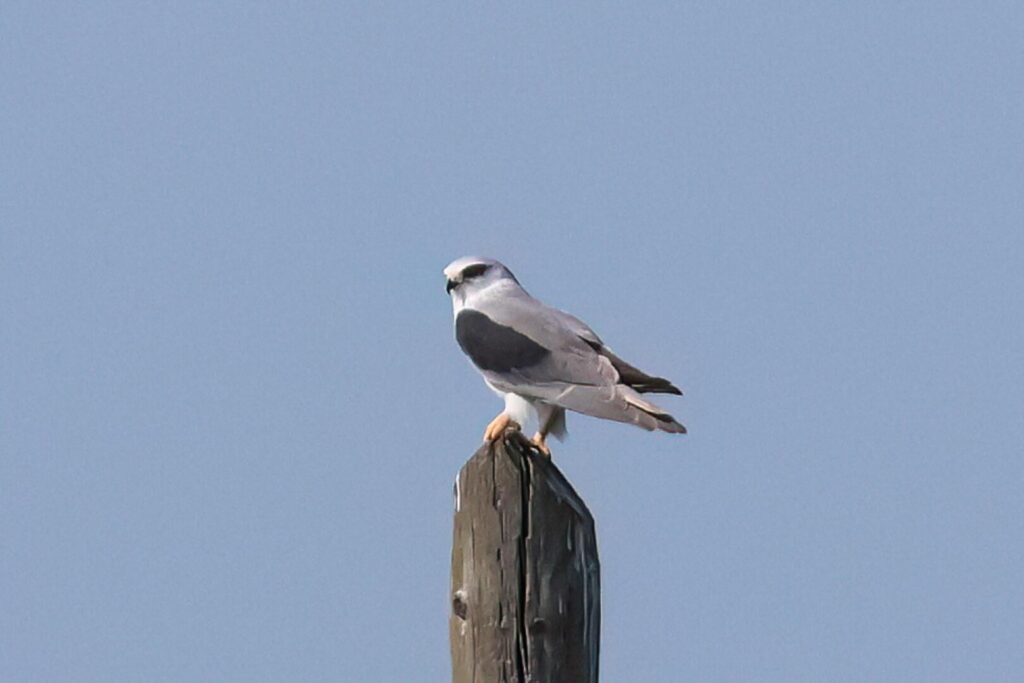
Great to watch it and well worth popping back here, it was time now for us to head back to get something to eat ourselves. After dinner, we retired to bed. Unfortunately, it was only later that the Scops Owl started calling outside – too late to wake everyone up again.
Monday 15th April
Heading up towards Monfragüe National Park this morning, we had a quick stop first at the bridge over the River Almonte. Several Serins and a smart male Greenfinch were feeding on the dusty track where we parked and Crag Martins and House Martins were hawking overhead and going in and out of the nearby culvert. As we crossed the road and walked down towards the river, several Spanish Sparrows flew in and out of the bushes nearby, some flying up into a nearby small ash tree where on closer inspection we could see lots of half built nests.
Then two pale birds came up from the same area, probably from a small stream bed hidden by the bushes, and as they flew away from us we could see the distinctive white tip to their tails – Rock Sparrows. Unfortunately they just kept going, over the river and up over the hillside beyond. We could hear several Nightingales singing and as we walked down to the water we saw one fly across ahead of us. It landed in the top of a tree on the far side of the river where we could get it in the scope, and see its bill opening and closing in time with the song.
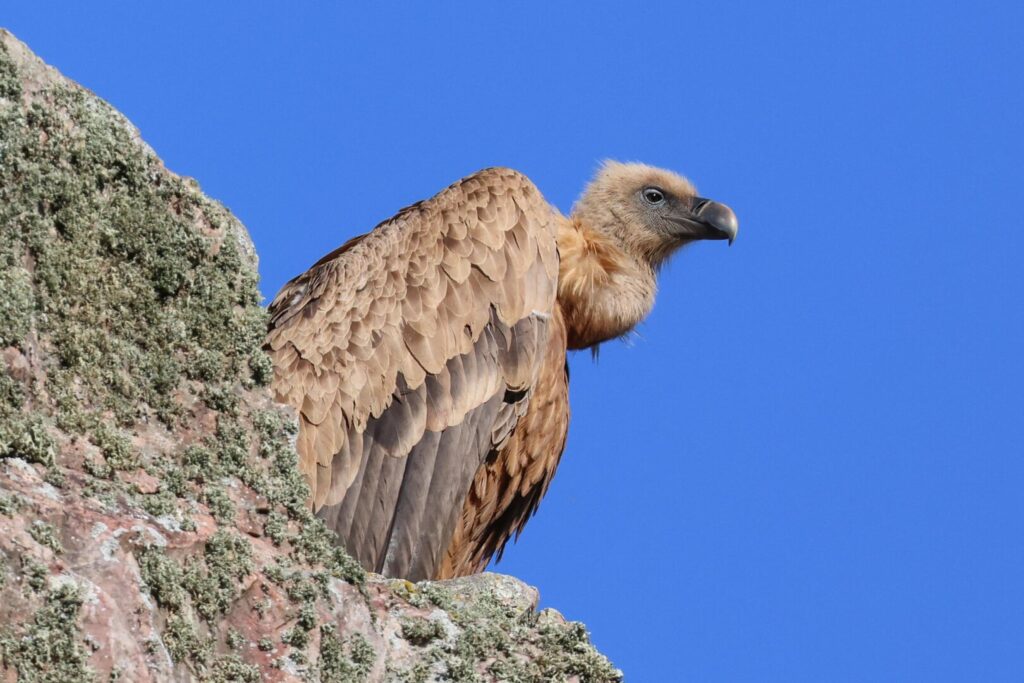
Into the National Park, we had another stop briefly at the bridge over Arroyo de la Vid. There were several Red-rumped Swallows flying in and out from under the bridge, as well as the regular Crag Martins, and lots of Serins and Nightingales in the bushes but not much else today so we pressed on. It was still quite early and just starting to warm up, so we headed straight to the Salto del Gitano viewpoint.
As we got out of the minibus, a male Blue Rock Thrush was singing up on the crag above us and shortly after a male Rock Bunting appeared up there too. There were lots of vultures on the rocks, a few Griffons on the pinnacle of rock directly above the car park, staring down at us, and more on the Peña Falcon rock face opposite, including one or two Black Vultures as well. An Egyptian Vulture flew in across in front of the rocks and circled round.
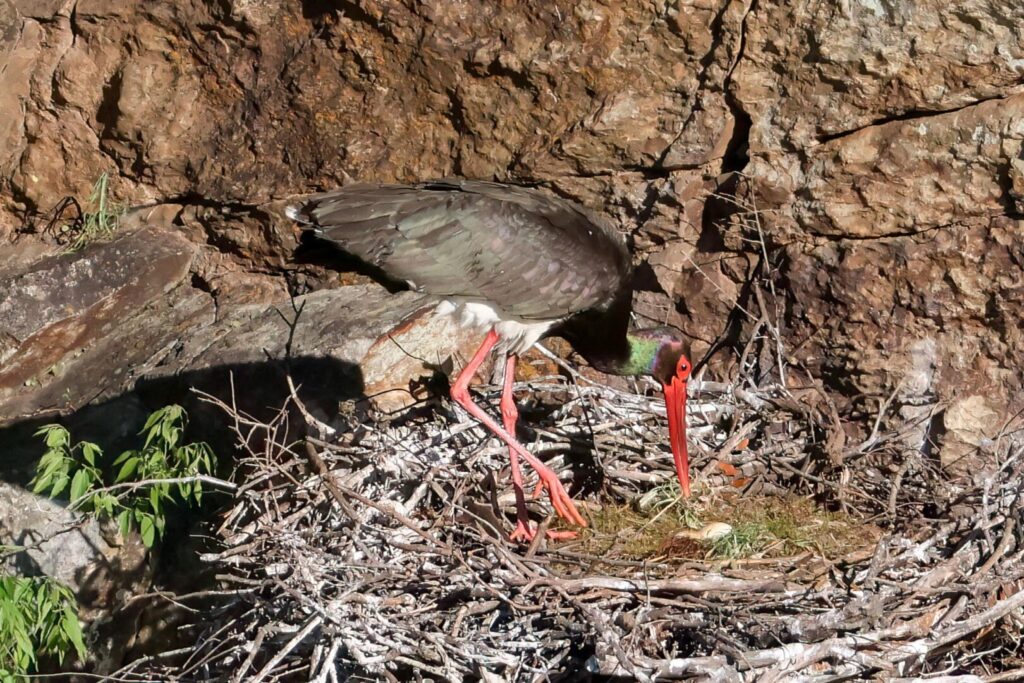
Looking down closer to water level, we could see a Black Stork on its nest, so we walked round to the other side of the pinnacle for a closer view. It was sat down brooding initially and when it stood up we could see it had two eggs in the nest. The Blue Rock Thrush flew down over the road now and landed on the top of the rocks just below the viewpoint where it continued to sing.
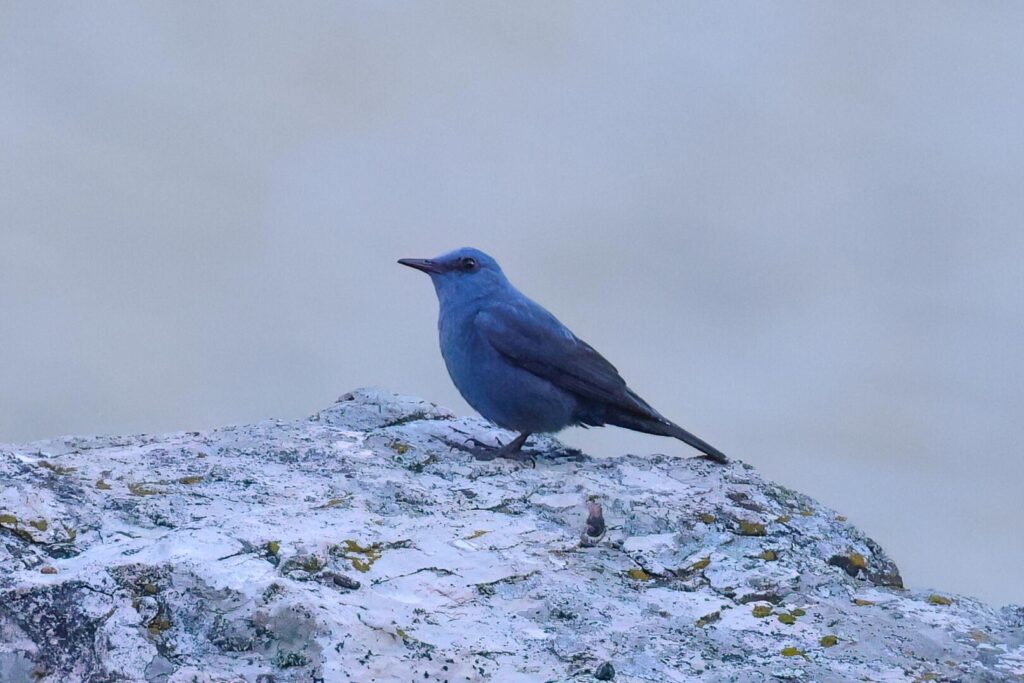
As we walked a little down the road to the viewpoint directly above it, a smart male Rock Bunting flew across ahead of us and landed low on the cliff face before dropping down onto the verge to collect food. It or another then appeared on the top of the rocks below us, where it stopped to sing. A pair of Black Redstarts was high up on the rocks, the male singing, and a White Wagtail looked rather out of place nearby – it seemed to think it was a Blue Rock Thrush!
A male Sardinian Warbler showed off in the trees right below us, a Wren was singing and eventually appeared on the rocks, Crag Martins and Red-rumped Swallows drifted up and down, and Serins and a few Linnets flew past.
It was gradually warming up now and we looked up to see lots of the Griffon Vultures taking off from Peña Falcon opposite and circling in the sky above – quite a sight. The ones on the pinnacle close to us took off too and a large kettle now circled right above our heads. Others remained on their nests, and we could see one with a well grown chick and some flew back and forth low across the water, one returning to the pinnacle next to us with a bill full of nest material.
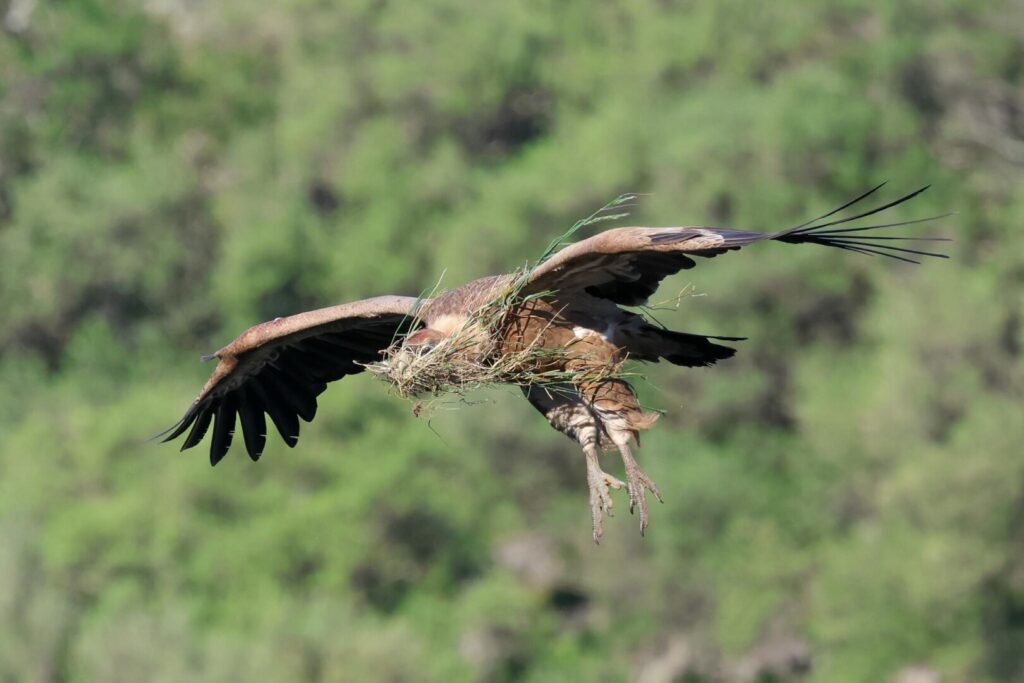
We could easily have stayed all day just at Salto del Gitano, but we decided to move on and have a walk now, before it got too hot. Walking back to the minibus, a female Rock Bunting was hopping around in the parking area – it crossed the road and we watched it collecting nest material on the verge before it was flushed by a passing car.
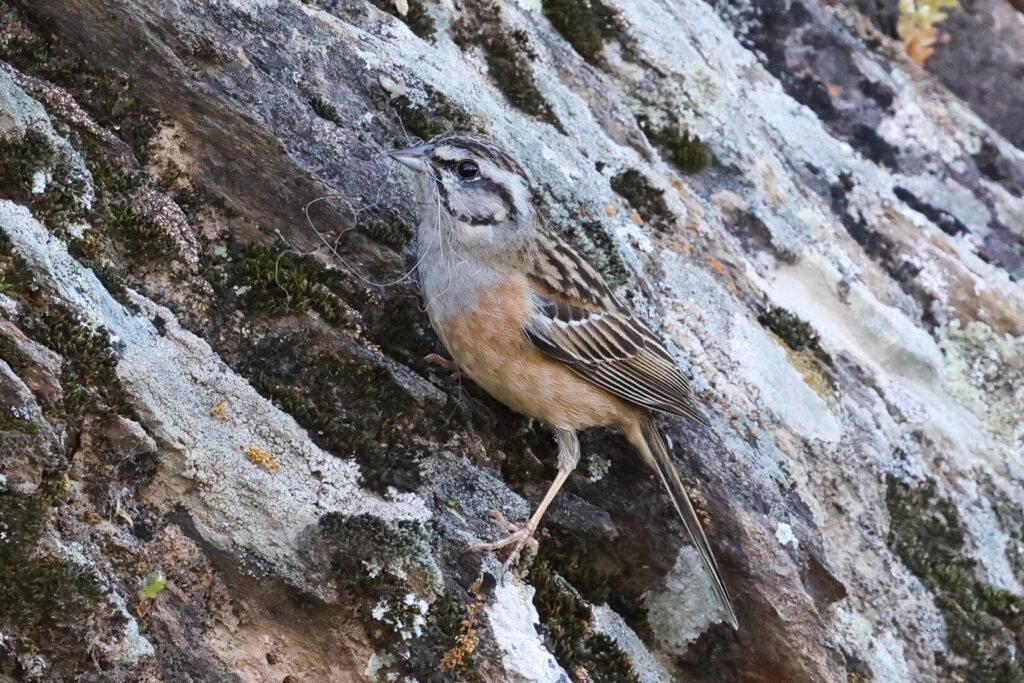
As we drove on up to Villareal de San Carlos, we marvelled at the clouds of House Martins around the bridge over the River Tajo and further up a small group of Red Deer was spooked by the traffic and ran off through the bushes.
We parked and got out again and took one of the tracks which dropped down through the hills. A Common Cuckoo flew in and landed briefly on a bush right in front of us – a striking rusty orange female, known as ‘rufous’ or ‘hepatic phase’, a colour form which is commoner in southern Europe than back in UK. A pair of Dartford Warblers flew off over the bushes ahead of us and further down we found one closer to the path, feeding in the bottom of the vegetation.
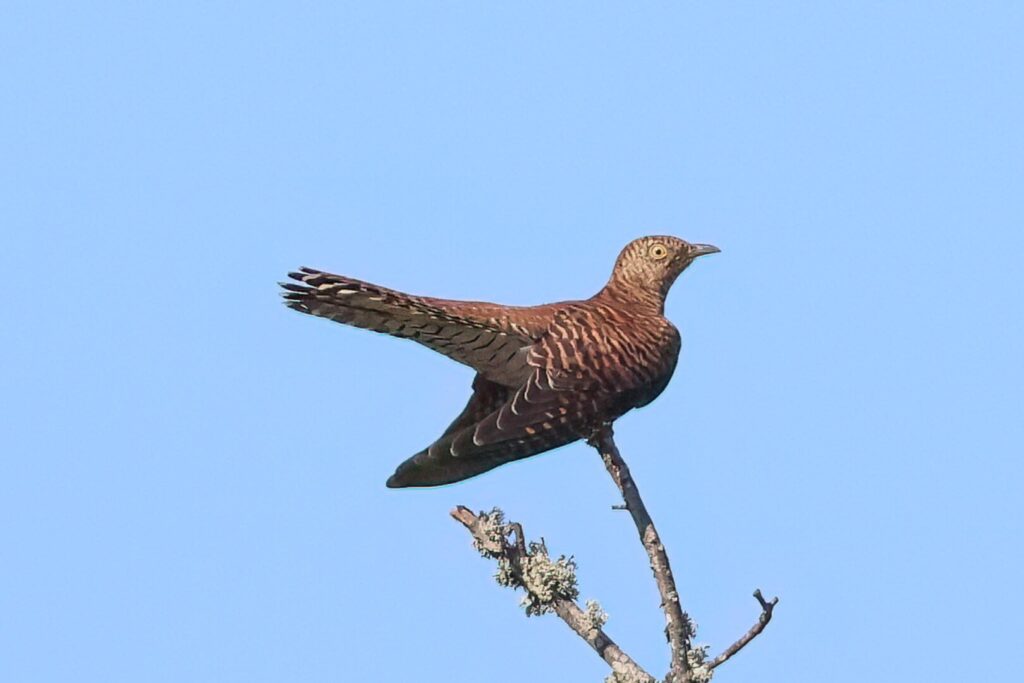
Further down, in the trees by the stream, we could hear a Golden Oriole fluting and a Grey Wagtail was down on the rocks by the water. There were lots of Chaffinches and Blackbirds in the trees too, and a brief female Blackcap, and we heard a Short-toed Treecreeper singing on and off before it eventually flew in and landed on a trunk right in front of us where it stayed still singing for several minutes. There were lots of butterflies here, most of which would not stop, but we did see a Nettle-tree Butterfly and a couple of Small Heaths which landed on the track.
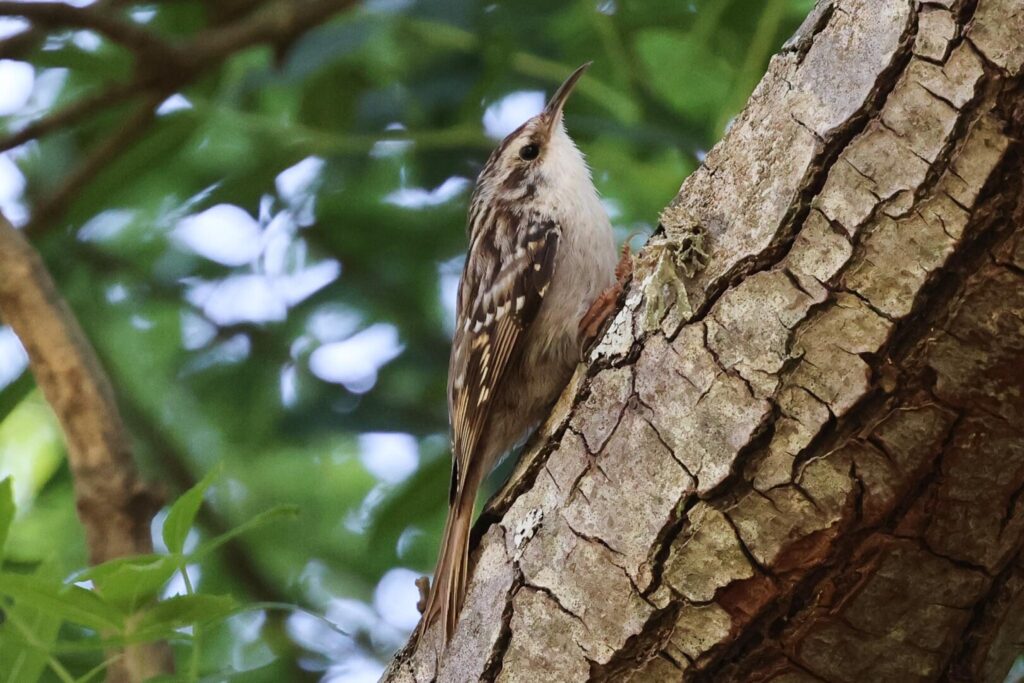
The temperature was rising fast now, so we made our way back up to the minibus. A Woodchat Shrike was perched on the wires above us and a couple of Black Vultures drifted past low overhead. We opted for an early lunch again, making use of the covered picnic tables in the village where we could sit in the shade, before it got too busy.
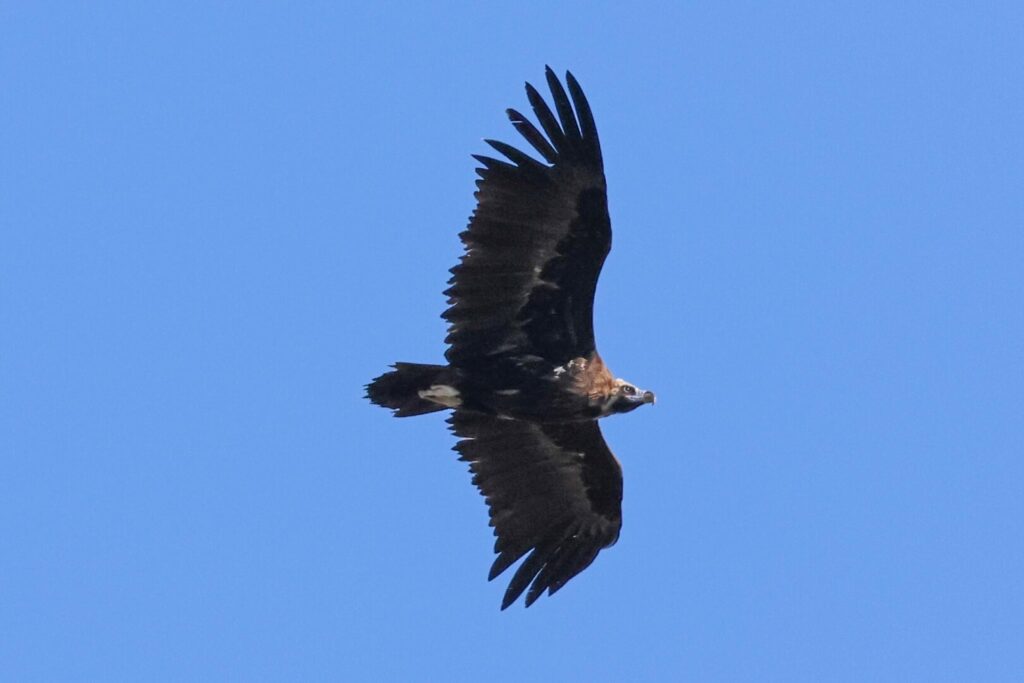
After lunch, we continued on through the park. We had a brief stop at the Mirador La Tajadilla, where there were yet more vultures flying in and out of the cliff face opposite. There were quite a few people in the picnic area now and few birds in the trees apart from House Sparrows and Serins. We managed to park in the small parking layby before the Portilla del Tietar, although it was largely taken up by two huge campervans, and as we got out we looked up to see an Egyptian Vulture circling overhead with three Black Storks.
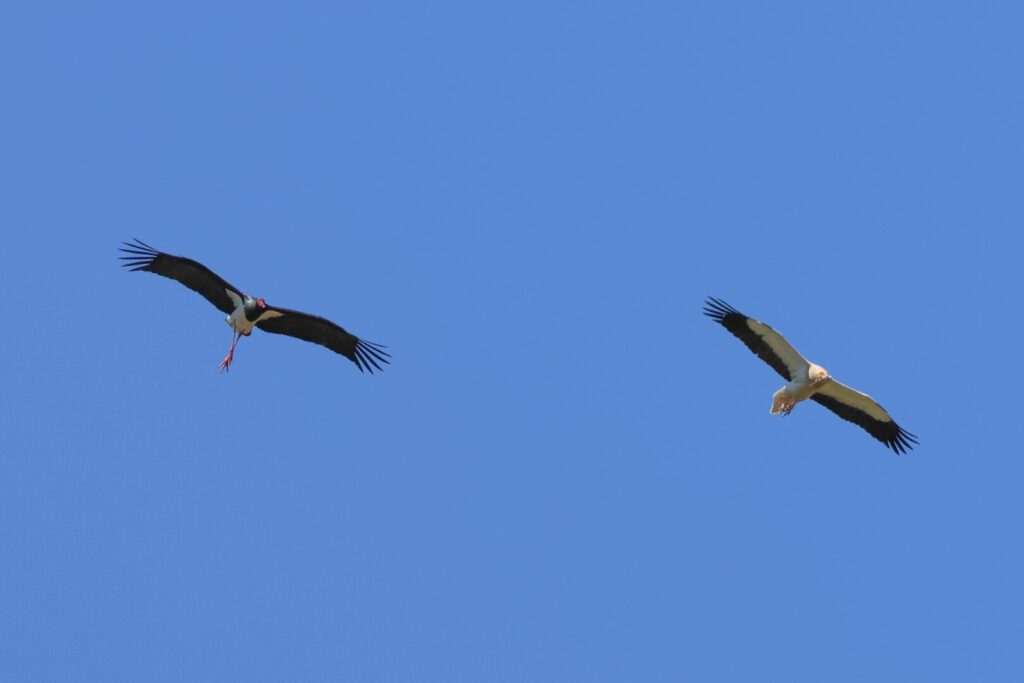
As we walked down towards the viewpoint, another Rock Bunting flew up from the side of the road and another Blue Rock Thrush was singing from the rocks behind. We hadn’t even got to the viewpoint before one of the Spanish Imperial Eagles flew in low over the hillside and over the road ahead of us. We had another fantastic view of it as it circled in front of the cliffs opposite the viewpoint before gradually gaining height and drifting away.
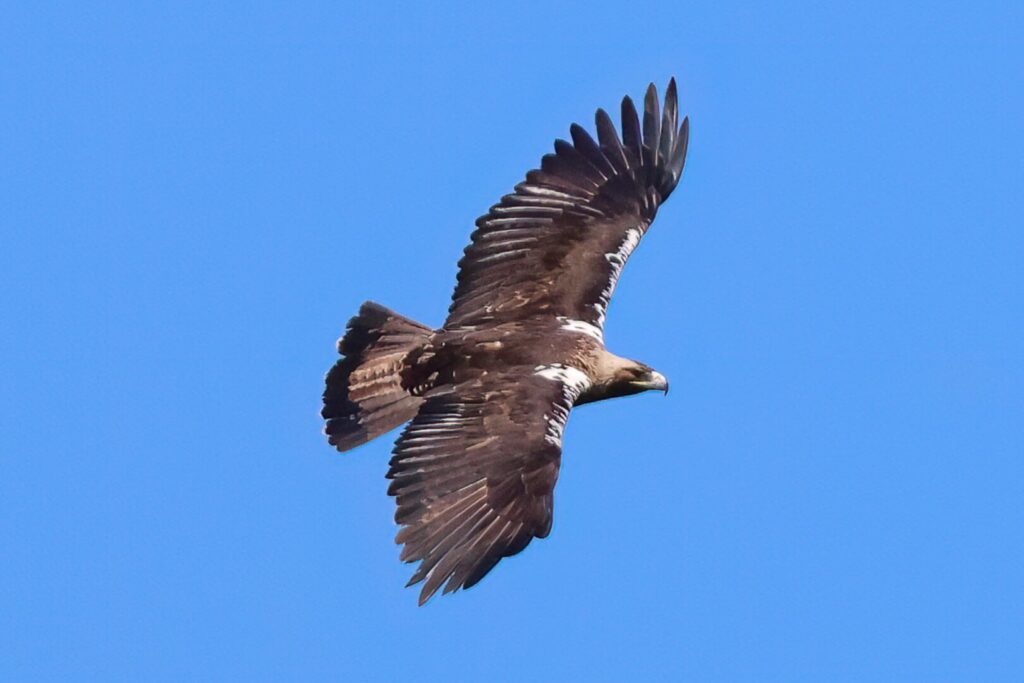
There were more Griffons on their nests on the rocks here, the Blue Rock Thrush flew back and forth singing between the small crag behind us and the cliff face across the river and a couple of Long-tailed Tits were feeding in the bushes right in front of the viewpoint. We had been told that a Western Subalpine Warbler had been singing here in front of the view point recently but perhaps because it was in the heat of the early afternoon we didn’t hear it until it eventually appeared in the tree right in the middle of the viewpoint. It flew off across the road and we could see it again feeding in the bushes.
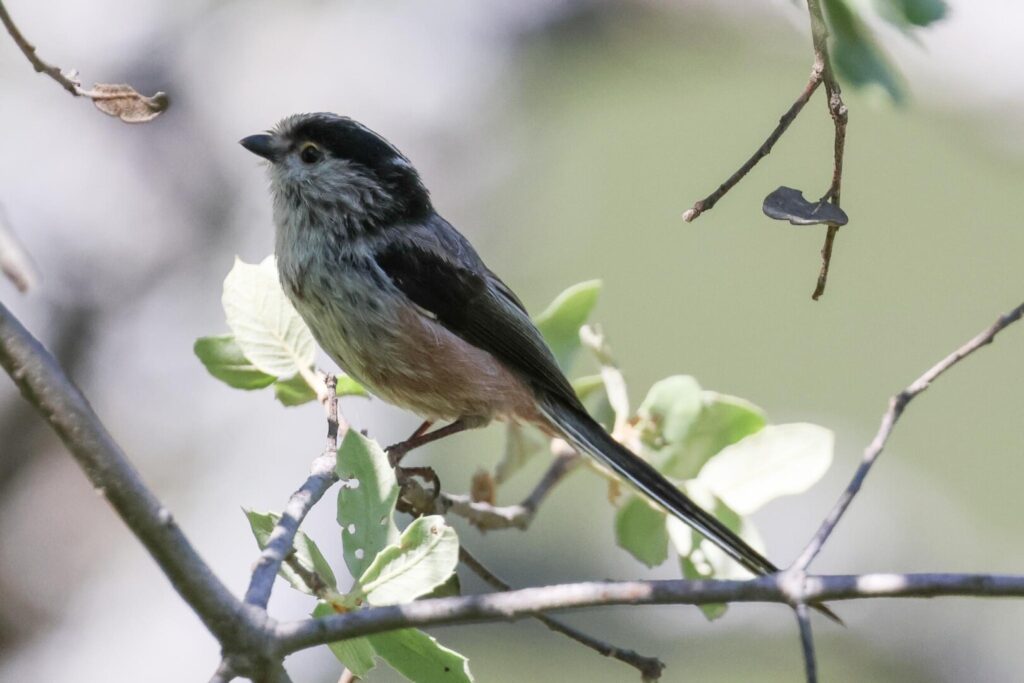
We drove on north out of the park and stopped again in an area of dehesa with cork oaks whose trunks had been stripped for their bark. As we stood and listened we could hear a Western Orphean Warbler which flew in and landed in the trees not far from where we had stopped. It continued to sing and we could see it moving around in the leaves before it came out into view on a bare bough.
A Nuthatch appeared in the same tree too and we watched it fly down to a nearby tree trunk where we could see it had a nest hole, and there were a few Iberian Magpies and a Woodchat Shrike here too. In the more open farmland beyond, we were hoping we might find a flock of Rock Sparrows but it was getting very hot now and activity had dropped noticeably.
There was no wish to walk up to the Castillo in the heat, so we decided to turn round and head back to Salto del Gitano again. We spent some more time marvelling at all the vultures, which were flying in and out more actively now. Three more Black Storks flew in and landed on the base of the cliff face opposite.
The Blue Rock Thrush was sticking to the rocks above us now but the White Wagtail flew in and landed on its favoured singing spot below instead. The male Black Redstart was feeding in the trees and the male Rock Bunting was singing from the shade on the side of the pinnacle of Salto del Gitano.
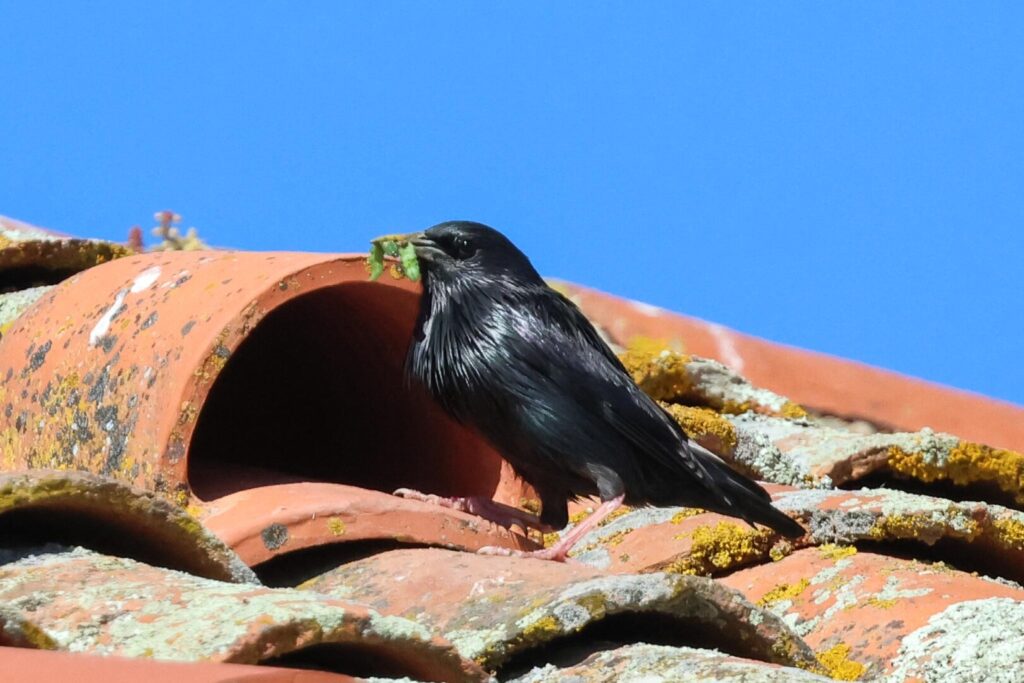
It was just after 4pm, so we decided to drive back to Trujillo and have a look at the bullring. We stopped at a filling station first, to have a break for an ice cream or cold drink, and it was after 5pm by the time we got there but the temperature was still not really starting to drop. A succession of Spotless Starlings landed on top of the bullring and we watched some of them with nest material or food, going in and out of the specially placed tiles which allow access to the roof space below, where they nest.
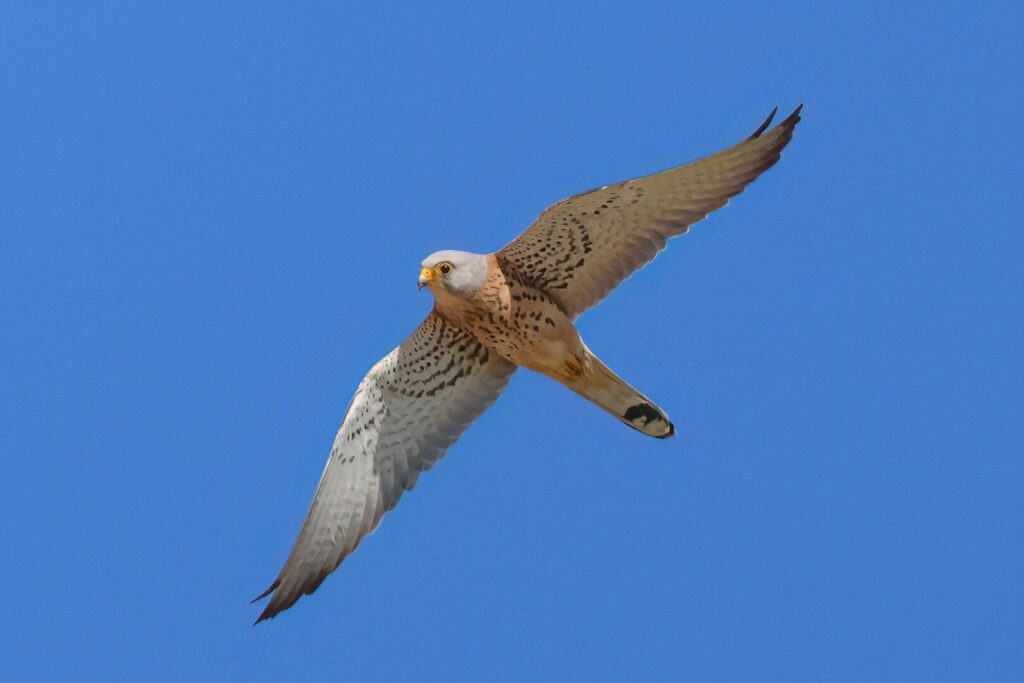
The Lesser Kestrels also nest here and there were at least seven displaying above the bullring, fluttering their wings and calling, flying round with prey in their talons. They were not showing any signs of landing or going in under the tiles though and kept drifting off out over the fields beyond. A couple of Booted Eagles circled over. Then it was back to Pago de San Clemente for a shower and a break before dinner.
Tuesday 16th April
Our destination for this morning was the plains of La Serena, about an hour’s drive from Pago de San Clemente, which was fairly uneventful until we got down towards Campanario. First two Little Bustards flew across the road in front of us, the first a male with black neck, fluttering its white wings, followed by four Black-bellied Sandgrouse. Then a little further on, a male Montagu’s Harrier was hunting the field next to the road.
Unfortunately, on the main road there was nowhere to stop and we had traffic behind us but as we got on to the minor roads there was more chance to at least slow down and look, even if as soon as we did, a car always seemed to appear from nowhere behind us. We had two more Montagu’s Harriers now, another male followed by a female, and then further on we found a Little Owl perched on a fence post below the road.
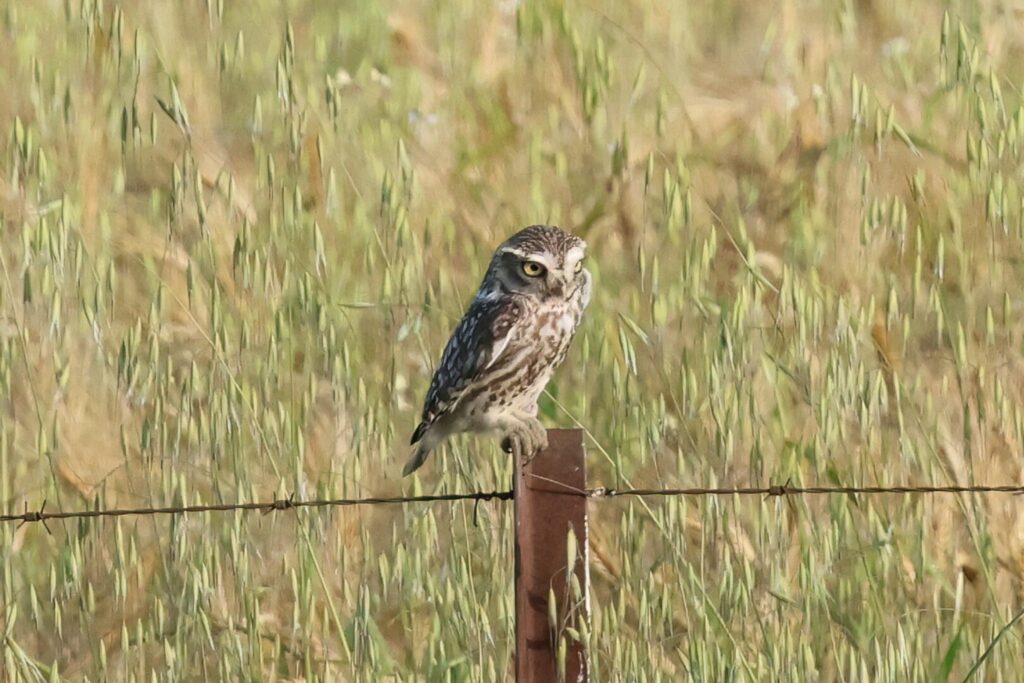
As we approached a road junction, we saw a Pin-tailed Sandgrouse dropping over a ridge ahead of us so we slowed to see if it might be in the next field over and one of the group spotted the head of a Little Bustard in the field the other side of the road. Thankfully, there was a gateway where we could pull off the road and it was far enough over so we could get out and get it in the scope, a female, and then a male flew up from somewhere over the back of the field and disappeared over the ridge beyond. We couldn’t see any sandgrouse in the field where the one had seemed to go down, but the vegetation was too high.
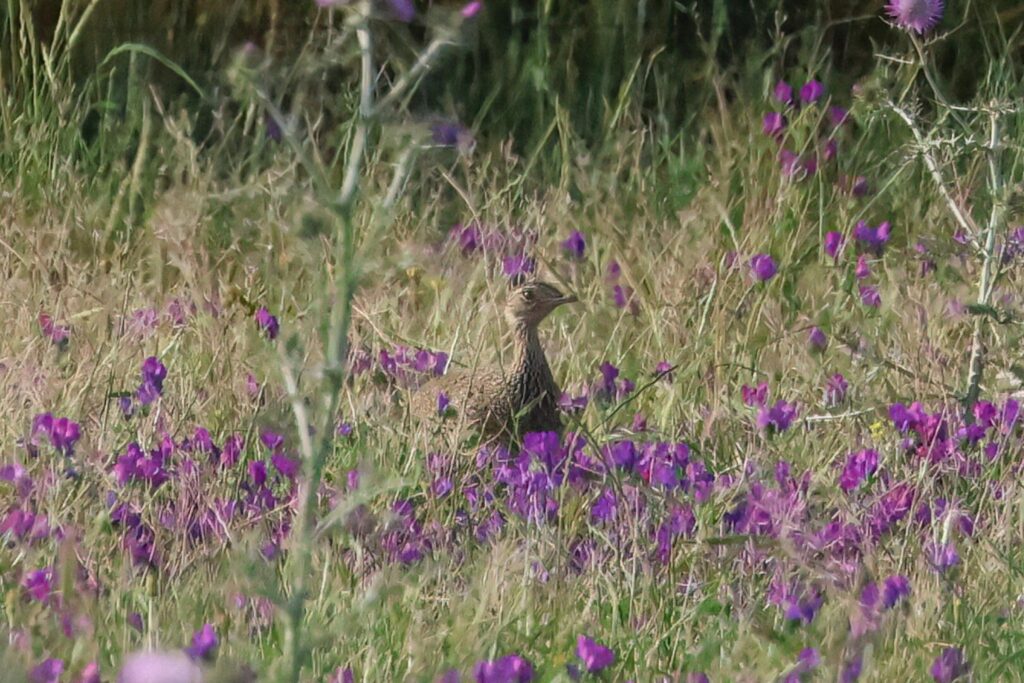
While we were watching the Little Bustard, we heard a group of four Pin-tailed Sandgrouse calling and saw them flying away in the distance. We got back in the minibus and turned right at the junction, first driving along to see if we could pick up the female Little Bustard closer from here but it flew as we slowed to scan and landed again further back out of view, then we continued on a little further to see if we could find the male which had flown this way earlier. There was no sign of it, with the grass much taller here, but there was a Roller on the wires and a very distant Great Bustard in flight.
We turned onto an unmade road now where it would be easier to stop and drove out onto the middle of the plains. We pulled over to scan and once again we were bathed in the sound of Calandra Larks singing all around. We quickly located a male Little Bustard displaying – it was a bit more distant than the female had been earlier, but through the scope we could see its black neck and we watched as it repeatedly threw its head back singing.
Further down the road, we could see a pair of Montagu’s Harriers over a field and as we watched them flying round over the crop we realised there were actually several pairs all using the same field. The first male had flown off to the left while two more males flew in from the right with prey in their talons. One of them dropped down, but the other circled over the crop as a female came up from the ground and circled underneath him, before he dropped the food and she caught it. The female landed on the road, presumably to eat it.
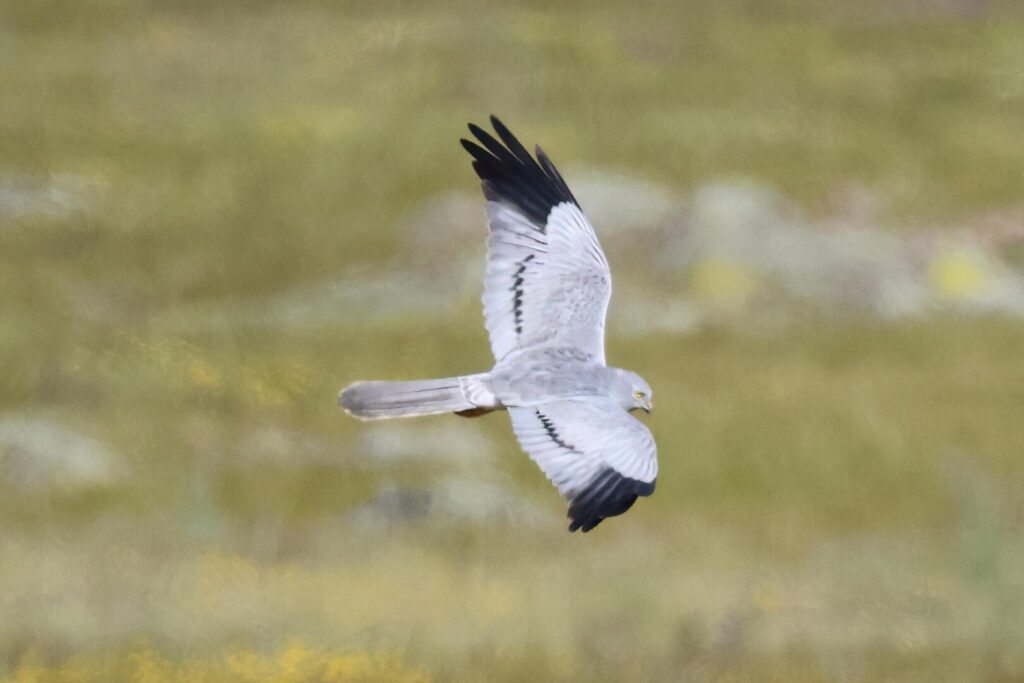
After we had finished watching the bustard, we drove down to see if we could see the harriers a bit closer but from the track, most of the field was out of view and we could only see a single female on a fence post. We drove on and the hillside beyond had been recently cultivated – three Stone Curlews dropped down at the back of the field out of view beyond a ridge, several Lesser Kestrels were perched on rocks out in the middle and another female Montagu’s Harrier came up just behind them. The fields beyond seemed to have taller crops in them, so we turned and headed back to the road.
It was already getting hot now and activity levels seemed to have dropped as we cut across to the minor road to Cabeza del Buey. A drove of eight Great Bustards were flying out over the grass off to left, but dropped down out of view, where we could just see a couple of heads.
We turned onto a side track out over the plains, to an area which has been good for Little Bustard in the past, but the vegetation here was very tall this year, albeit a riot of colour with all the flowers in bloom. The hillside beyond looked interesting, more closely grazed by sheep, so we drove on. We had planned to park by an old barn at the top of the hill to get out, but when we got there two large sheepdogs had been resting in the shade of the barn and one ran out and started barking all round us. We had a quick look from the minibus and couldn’t see anything obvious out on the grass, then decided to turn round and try another track.
We found somewhere quieter to stop now and got out to stretch our legs. On the slope opposite, we could see a male Great Bustard standing in the shorter grass and then a second male walked in towards it, the second bird with its tail raised and half fanned. As it got almost up to the first Great Bustard, the two of them just settled down in the grass and all but disappeared from view – it was probably getting too hot for much more bustard activity now.
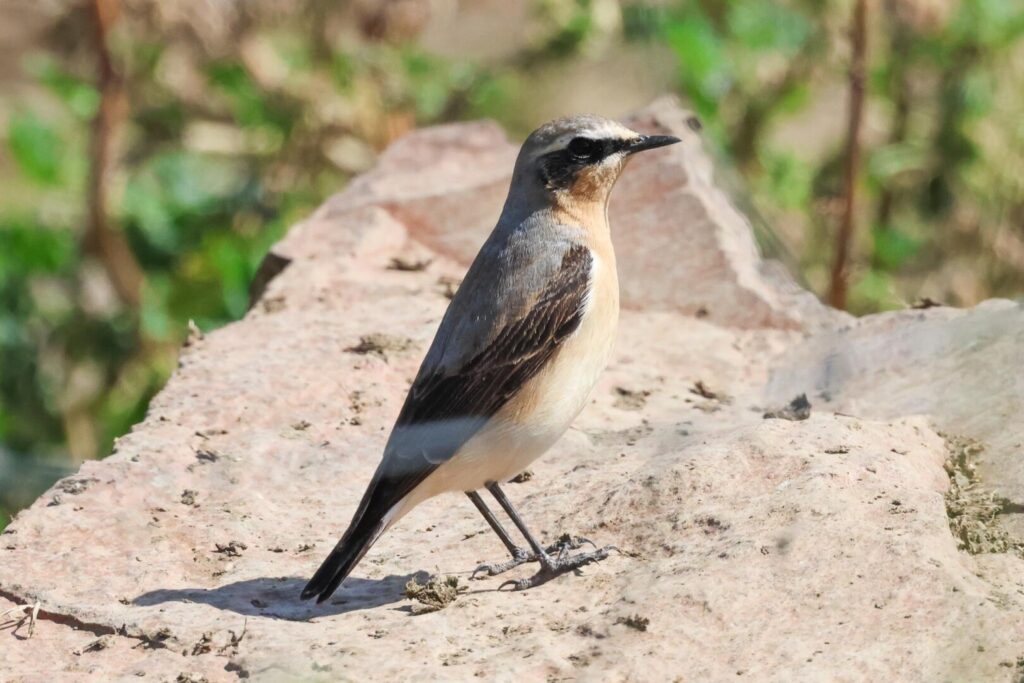
Driving on, the next hillside had been cultivated but held nothing more than larks and at the top of the hill we pulled up by a small paddock full of sheep by a barn to look at a Yellow Wagtail and a Hoopoe on the ground. Several Northern Wheatears appeared and then we realised there were several Whinchats with them, at least three. Two or three Willow Warblers were flitting around in the weedy vegetation on the verge and a male Redstart flew out and landed on the fence the other side of the road.
As we rolled slowly forward, the birds all moved ahead of us and a Nightingale shot out and straight back in further up. These were all migrants on their way north, stopping here to feed, but why they had all chosen this particular isolated spot in the middle of nowhere was anyone’s guess. Amazing to see them here though.
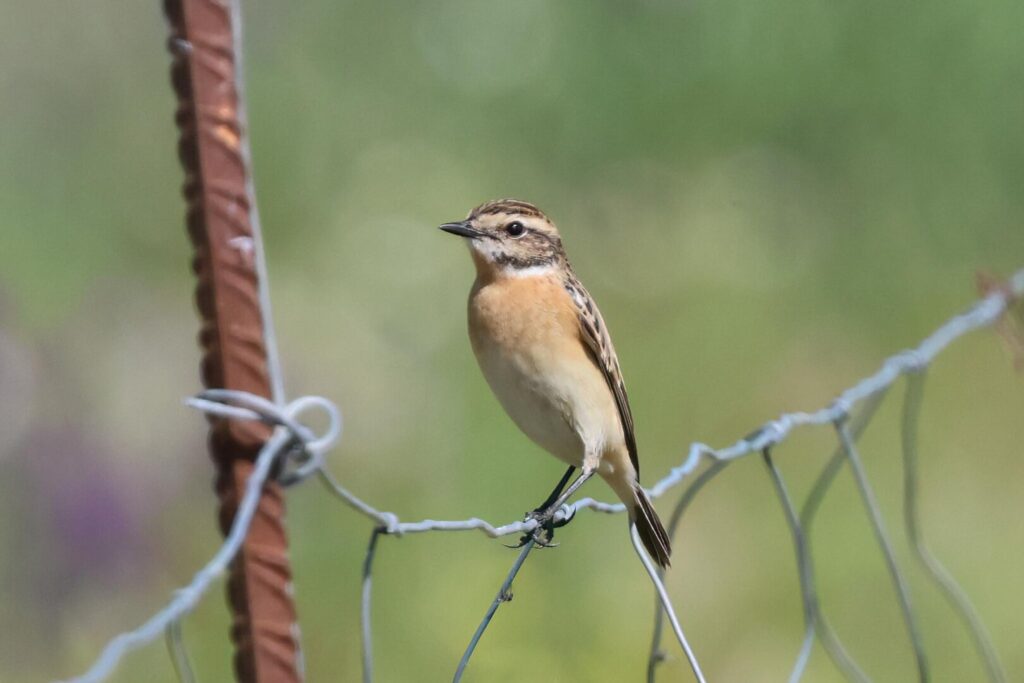
We drove on to the next junction but there were no more migrants along the fences further on, and the fields beyond were in the process of being cultivated by several tractors so we turned and headed back to the road.
It was time for lunch now, so we found another track and drove a short way down to a convenient gateway where we could park up. Several more of the fields here had been cultivated, and a Short-toed Lark was picking around between the clods of earth in front of us. Four Northern Wheatears were in the field on the next ridge up, one smaller nominate race bird in with three larger, darker ‘Greenland Wheatears’. A small kettle of vultures formed above us, a single Black Vulture with several Griffons and a pair of Ravens flew in kronking and circled in front of us. As it was getting steadily hotter now, we decided to head for the hills next and after we had finished our packed lunches we drove down to the sierras beyond the plain.
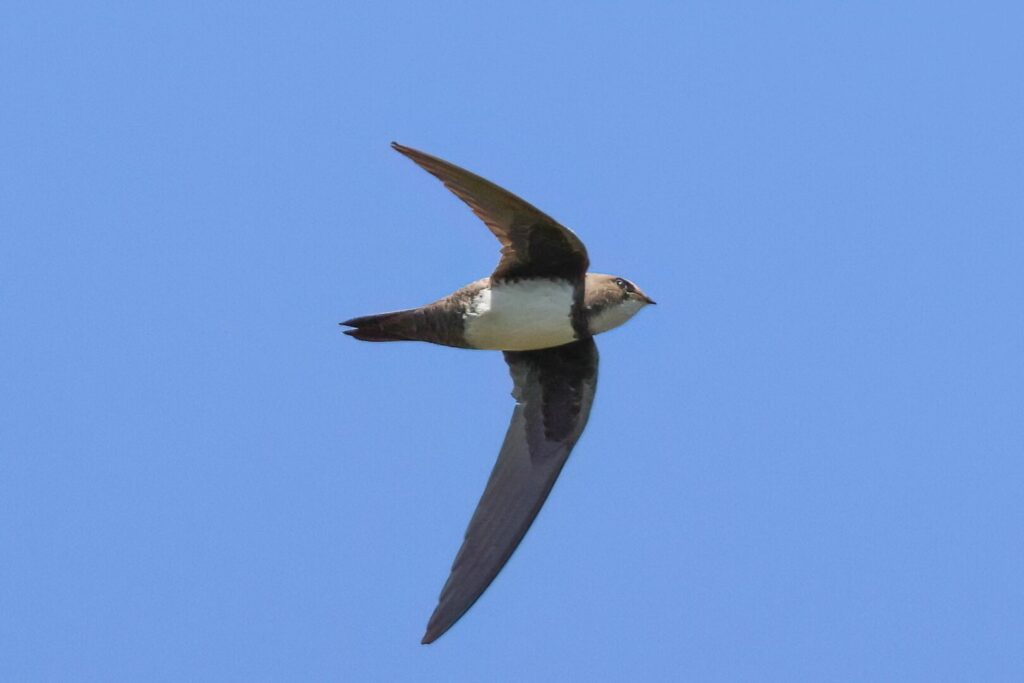
We drove round to the small town of Benquerencia de la Serena, where we climbed up to the ruined Moorish castle on the ridge beyond. A Black Wheatear was up on the rocks on the skyline above us, with a Rock Bunting further along, as we walked up the path. Several Crag Martins and Red-rumped Swallows patrolled up and down along the cliffs and we had glimpses of a few Alpine Swifts as they shot over the tops.
There were a few warblers in the trees here, more migrants stopping off on their long journey north, first a couple of Willow Warblers flycatching from an old olive tree. A warbler which kept darting out from a small bush growing from the top of the ridge looked much whiter below and through the scope we could confirm our suspicions – it was a Western Bonelli’s Warbler, a nice bonus as they are scarce on migration here.
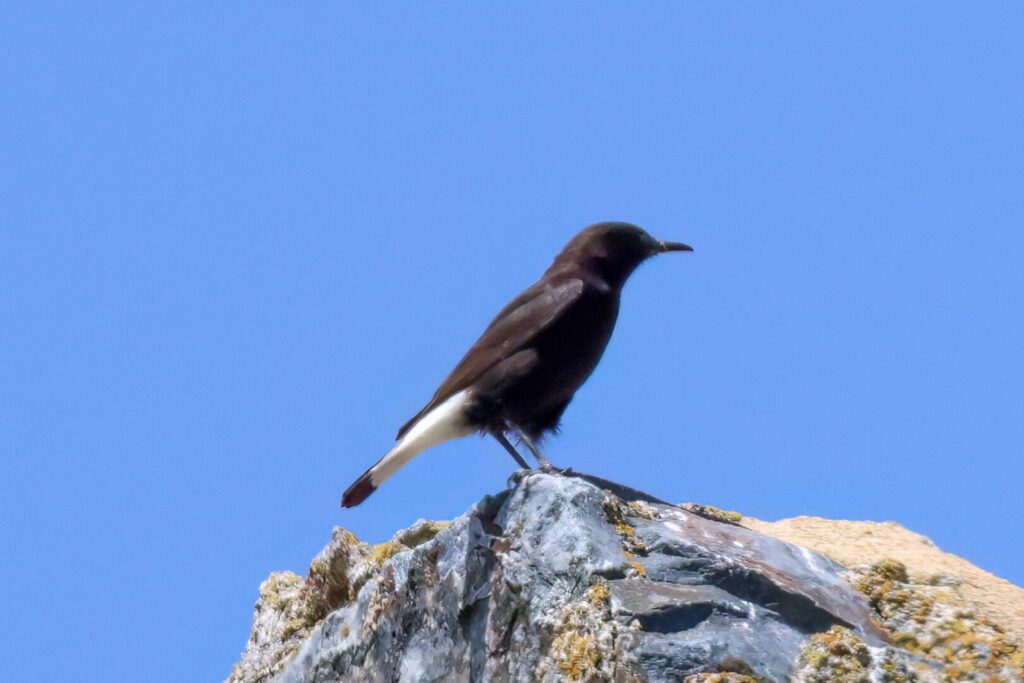
As we got up to the base of the castle, another Black Wheatear flicked up onto the rocks ahead of us. Climbing up the steps to the castle, we could appreciate the fantastic views out across the plains either side and see why they had chosen to build it here. There were lots of butterflies fluttering round the flowers on the top, mostly Swallowtails and a single Scarce Swallowtail, we could see a group of ten or so Alpine Swifts now, flashing up and down on the north side of the ridge calling, a large flock of Red-billed Choughs from time to time flew out of the ridge further up and a few Griffon Vultures and a couple of Black Storks drifted overhead. A great place to stand and watch the world go by.
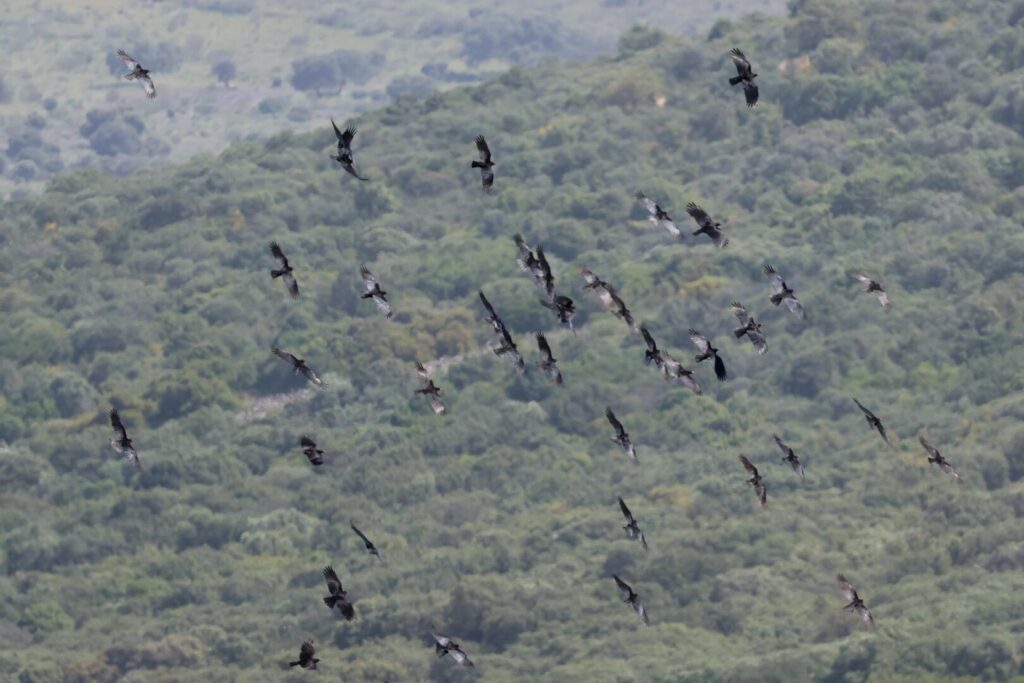
After a stop at a nearby filling station to get ice creams and cold drinks, we drove back north off the plains and into the river valley of the Rio Zujar. Coming in from the west end this time, we eventually found the service road which follows the river. A Little Egret was feeding in the shallows under the bridge, there were lots of Nightingales singing in the bushes, and where the road crossed a small tributary we found a couple of Common Sandpipers and a Green Sandpiper on the weir. We pulled up by some sallows and found a Melodious Warbler singing, smart with its bright lemon yellow underparts, they are only just returning to Extremadura for the breeding season.
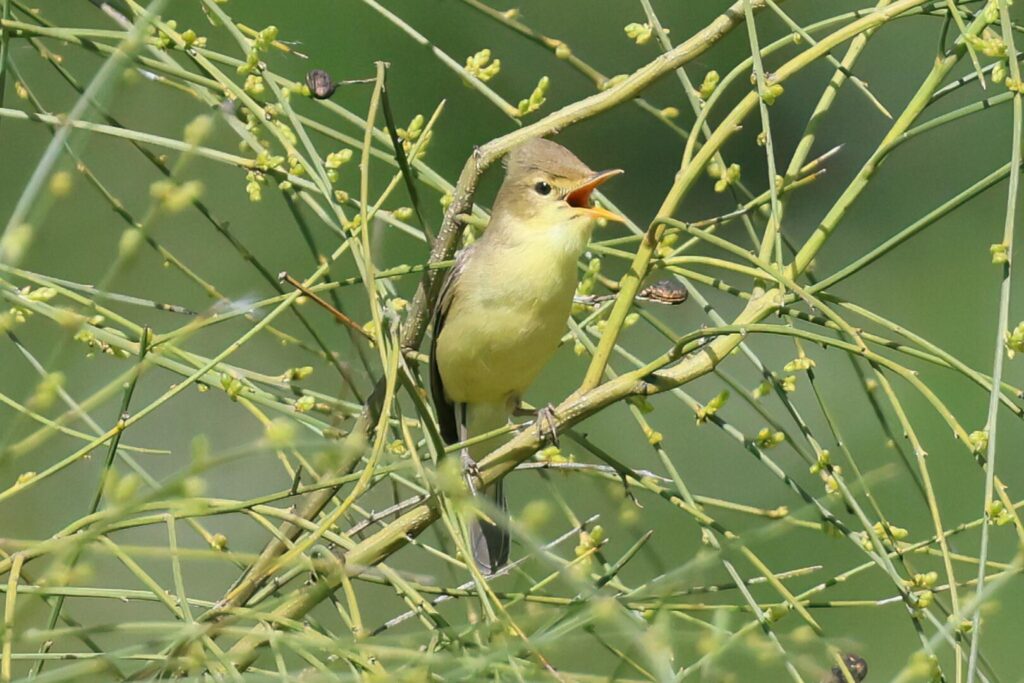
Further on, we stopped to watch and take photos at a small colony on Bee-eaters in a bank by the road. Pulling over again by an overgrown picnic area, a couple of Kingfishers were calling and flying in and out of the trees by the pool below, before we found ourselves at the dam and back up to the main road.
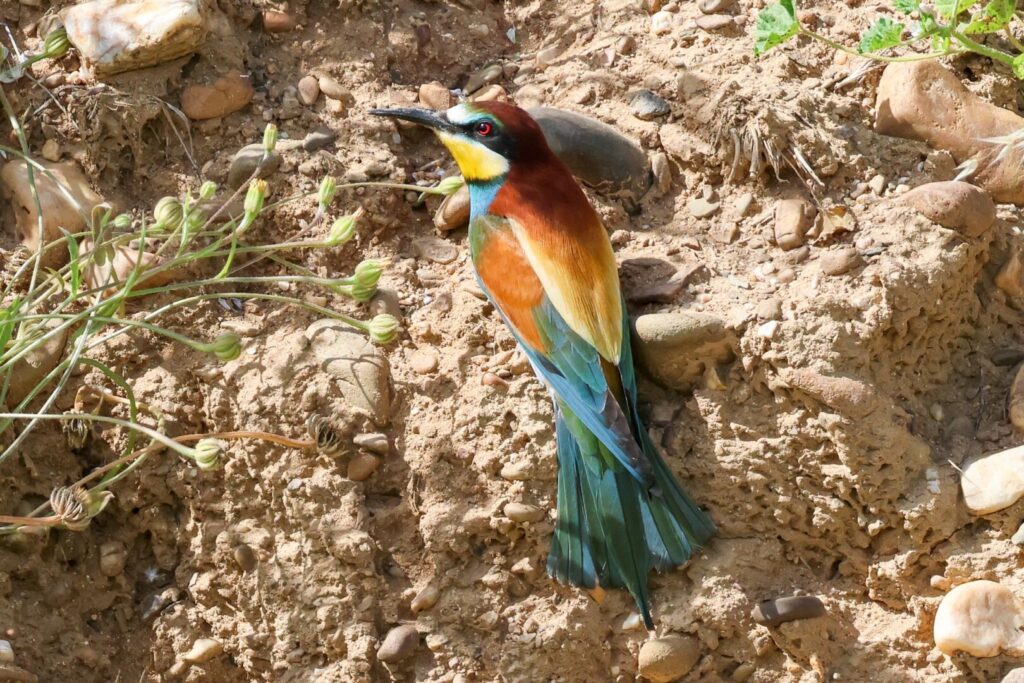
We were making our way gradually back to base, but we decided to try one last quick stop in the ricefields. We sometimes see Collared Pratincoles out on the plains of La Serena but we hadn’t today, so we turned off onto a track into an area where some had been a week or so ago. We weren’t entirely sure where they might be, or even if they were still here, but there were some nice muddy paddies here so we contented ourselves looking at the Black-winged Stilts and Iberian Yellow Wagtails, and found three Little Ringed Plovers while we were scanning the fields.
We were in luck, as we saw a couple of Collared Pratincoles fly round and land again in a ploughed field a bit further up the track, so we drove on to where we thought we could see them. When we stopped to look, we realised we were surrounded in pratincoles, several in the ploughed field looking into the light and at least six on a muddy patch the other side of the road closer to us, great views. We stopped and opened all the doors and windows, using the minibus as a mobile hide. Occasionally one would fly round or across the track in front of us.
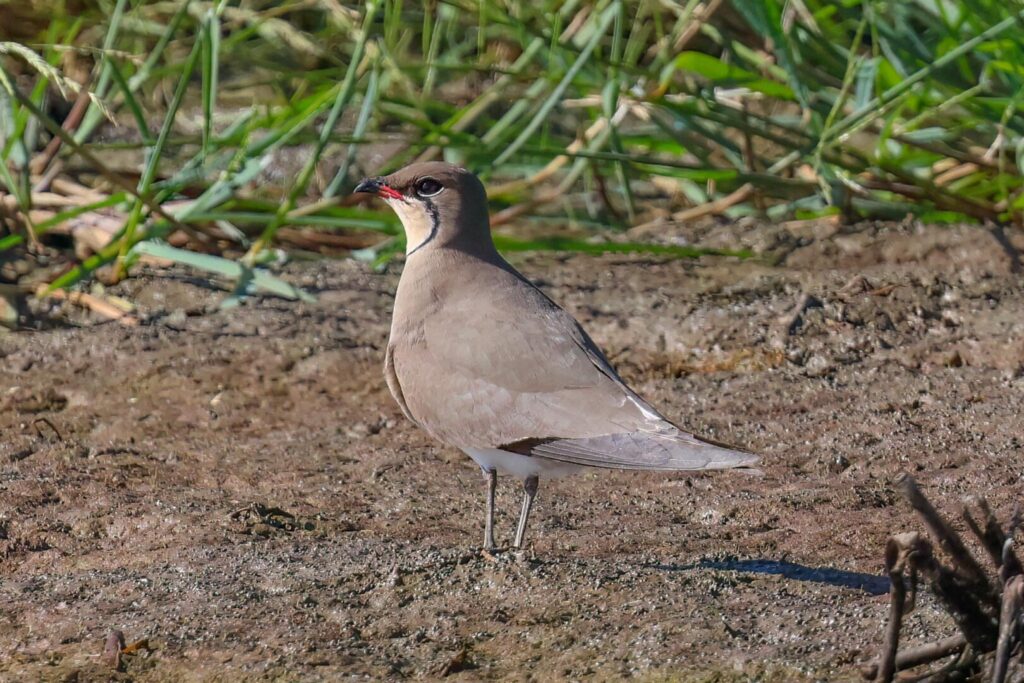
As is typical, even out on a track in the fields a car comes along behind and wants to pass, so we drove on to the end of the track to let the car past and then turned round to come back the other way. Something had spooked all the birds behind us and we could see now that there were many more Collared Pratincoles here than we had realised. We counted 90-100 flying round in a tight flock, twisting and turning, and several were still in the fields where we had been watching them before. The large flock quickly settled back down in the ploughed fields, many of them disappearing from view.
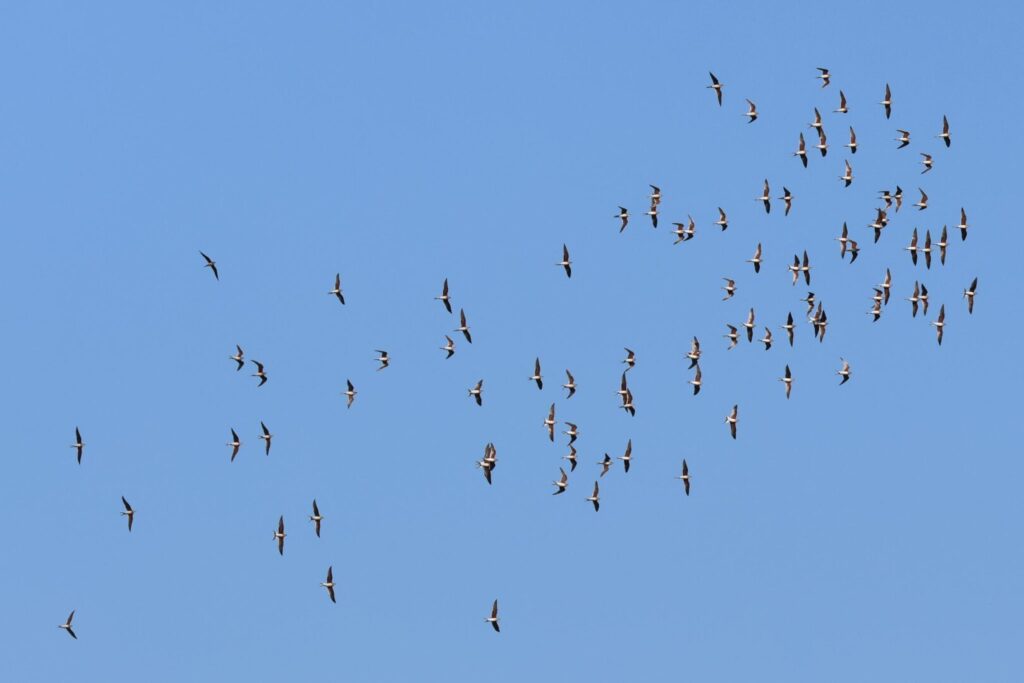
If that might have been a great way to end the day, there was still one last surprise in store for us. As we drove back home, a Great Spotted Cuckoo came up from the verge beside the road as we passed it. We could see it in the mirrors flying along the verges behind us, crossing from one side to the other as we slowed to a halt, and then it landed on a fence post. Thankfully there were no cars coming, so we could reverse back a short way and although it flew again, it clearly wanted to go back to the verge as it landed on the fence ahead of us now where we had a good view of it.
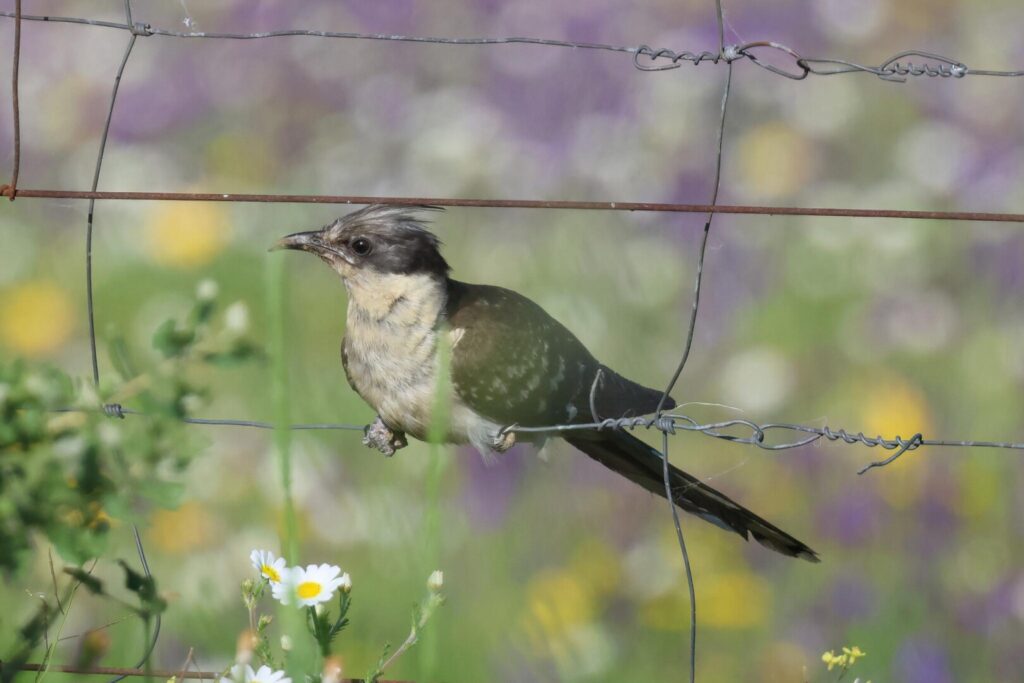
A nice bonus and with a lorry now approaching behind us, we drove on back to the guest house.
Wednesday 17th April
Having seen most of the birds we had wanted to find already, we decided to head up into the Sierra de las Villuercas today, where there were a few species we could possibly still add to the tally and we could enjoy the dramatic scenery.
Martin had given us a couple of different local sites to try on the way, so we drove up into the hills and stopped at a small picnic area in the dehesa which here was populated mainly with deciduous Pyrenean oaks which were just starting to come into leaf. A couple of vehicles turned in over the cattle grid and down the track as we got out of the minibus and scanned the surrounding countryside, unusually busy for out here in the middle of nowhere.
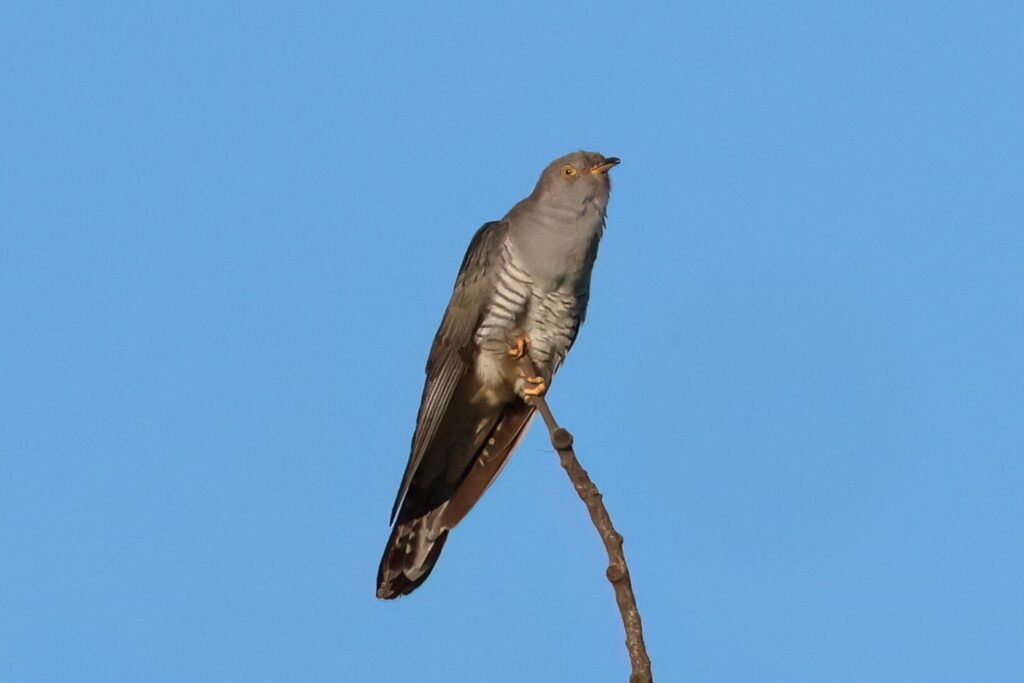
There were several Stonechats on the fence and a Cirl Bunting flew in and perched obligingly first on the wire and then in a nearby tree where we could get it in the scope. We walked over the cattle grid and down along the track and found a couple of Hawfinches in the trees, which we had a good look at.
Several Common Cuckoos were calling and one was perched on the top of a tree out in the middle so we walked over for a closer view, finding lots of Woodchat Shrikes here too. We watched a pair displaying, the male bobbing his head as he chased the female through the branches. Back down on the track, a Blackcap was singing.
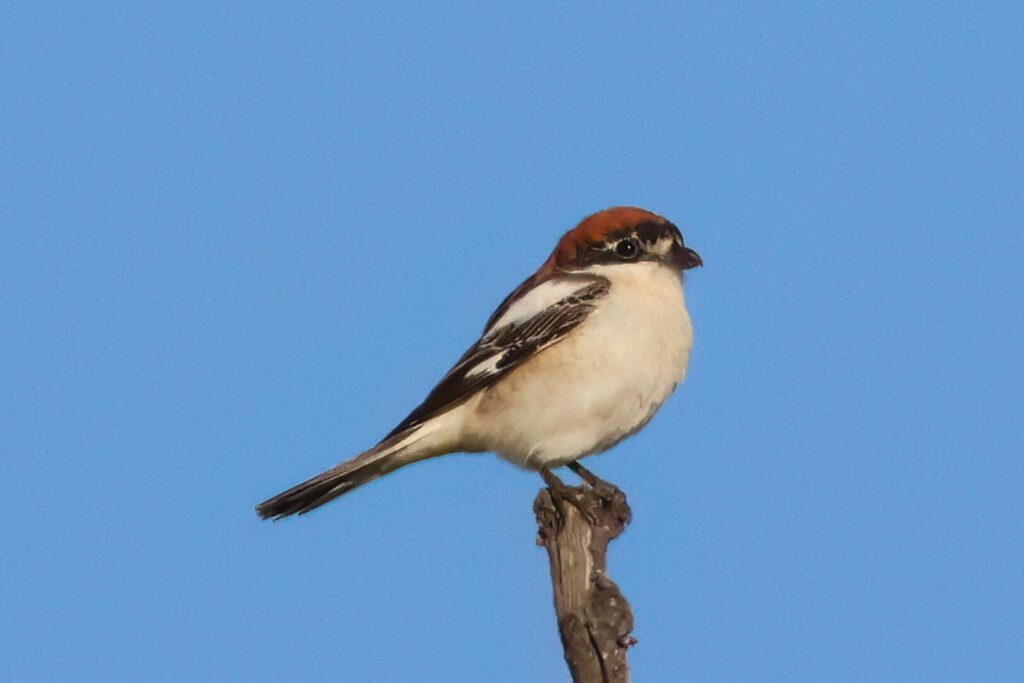
We had come here partly to try to get better views of Rock Sparrow, but as we continued along the track we could hear cowbells and now realised the reason for all the vehicles – they were moving the large herd of cattle from the next field over into the dehesa where we were walking. The cows ran past us now, so we moved to one side and let them pass, down to the gate back where we had parked where some stood for a couple of minutes like they were waiting to be let out, then they turned and ran back past us the way they had just come.
There had been a strong smell in the air as we walked in and now a lorry and a truck appeared at the gate, the former had a grab which reached out and picked up a dead cow from the ditch by the road, where it had clearly been placed earlier for collection. Another couple of trucks drove in and we spoke to one of the farm workers who confirmed that the cows were being moved onto the dehesa here this morning, so with all the disturbance too, we decided to move on.
A couple of Wrynecks were heard in the last few days along a track a little further up, so we continued on there now. We parked at the start of the track and had to wait while a couple of lorries came out first, one of which had seen picking up the dead cow earlier. There were several Serins in the bushes and a male Blackcap was singing which we found in a tree by the track with a female nearby. Walking down along the lane, the most striking thing was the number of Common Nightingales singing, every few metres another one, and several perched out in the trees where we could see them now. A Melodious Warbler flicked in and out of the bushes ahead of us.
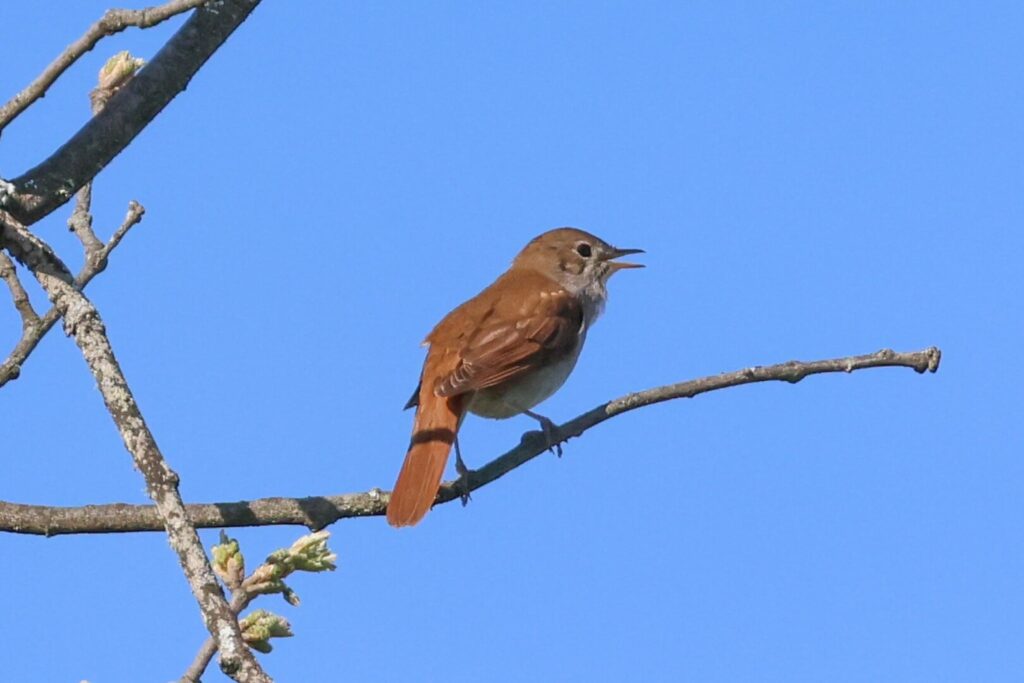
Down from at a concrete bridge over the stream, a couple of Bee-eaters were hawking out over the water and landing in a nearby dead tree. A Cetti’s Warbler was calling and flew across, disappearing into a thick clump of brambles. Just beyond, we stopped by a more open area, where there were more Stonechats, a couple of Corn Buntings and a Grey Wagtail which landed in a tree. A rather tatty Spanish Festoon butterfly landed to sun itself on the fence beside the track. Surprisingly, there was neither sight nor sound of any Wrynecks this morning though, unfortunately, so we turned and walked back to where we had parked.
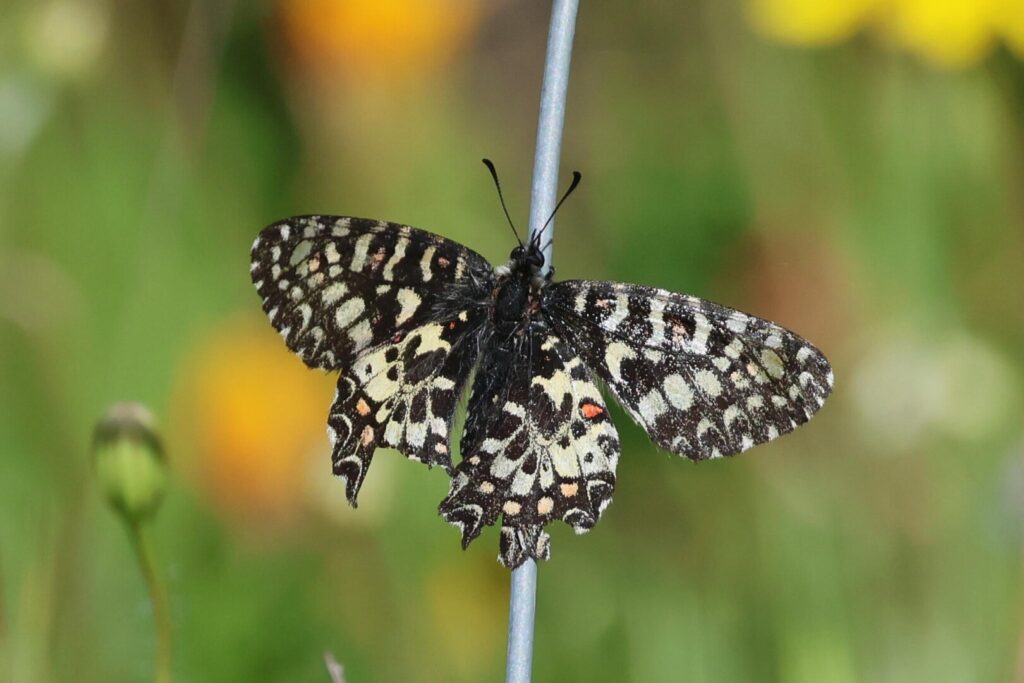
We took the scenic route over the hills towards Berzocana, up into the hillsides covered with gum cistus, although we could see some large areas had been cleared recently and then came across a couple of bulldozers scraping the bushes off another slope. Just beyond, a Western Subalpine Warbler flew up and landed in the bushes right next to the road where we pulled up briefly to watch it beside the minibus. Another was singing a bit further along and several Linnets flew up from the road ahead of us.
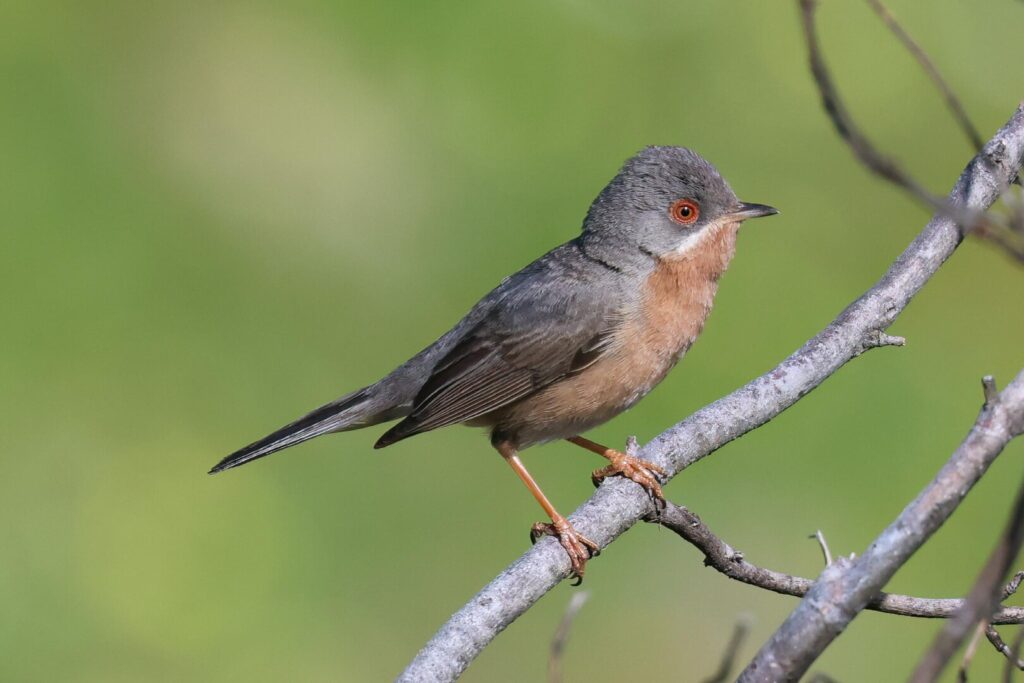
We stopped mainly to admire the view and as we got out we could hear a Woodlark singing in the distance. A Western Orphean Warbler was singing in the dehesa below us too and we eventually had some nice views of it in the evergreen oaks. A pair of Sardinian Warblers were coming in and out of a nest beside the road carrying food for their young. The views were pretty good out towards the Villuercas too. Continuing on, we dropped down into a valley and over a bridge, where a Kingfisher was perched on a section of wire fencing strung across over of the arches below and a couple of Grey Wagtail were on the rocks. Up towards Berzocana, the hillsides were more open and we saw a couple of Iberian Grey Shrikes as we passed.
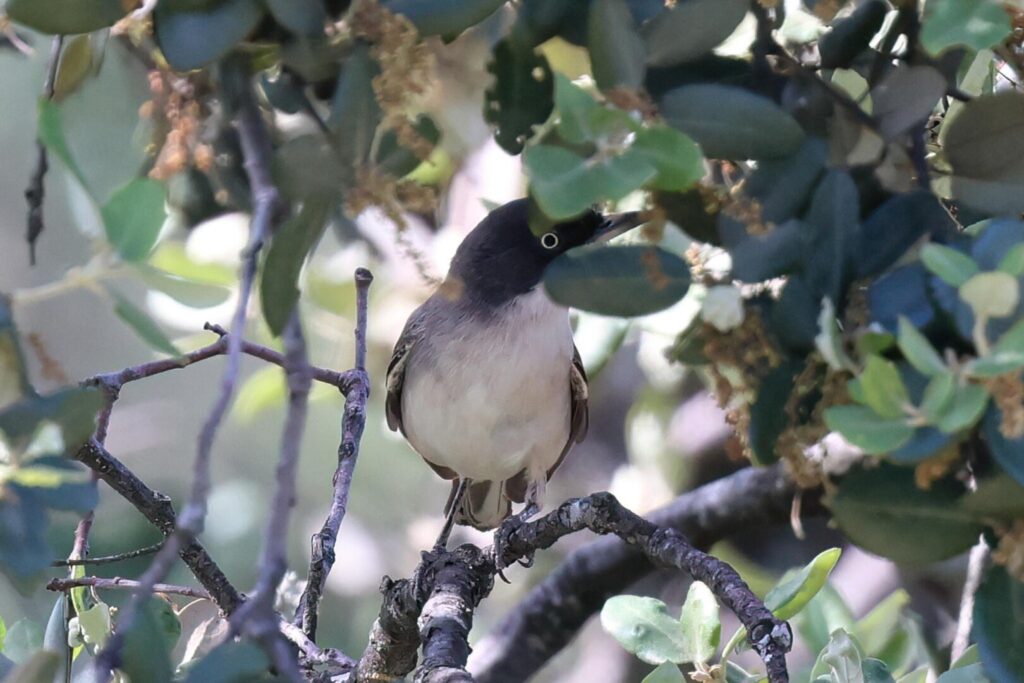
Just beyond Berzocana, we stopped at a small picnic area for lunch. A Eurasian Jay flew into the oak tree above us as we got out, a Nightingale was belting out its song right beside the picnic tables and above all the din it was making we could just hear one or two Robins singing too. We have had woodpeckers here before so we had a listen by the trees opposite after lunch, but there was no sound of anything now. We continued up to a higher pass and stopped at a pull in at the top. This is normally a good area for Crested Tit and we didn’t have to wait long before we heard them calling and then watched a pair feeding in the trees just below us.
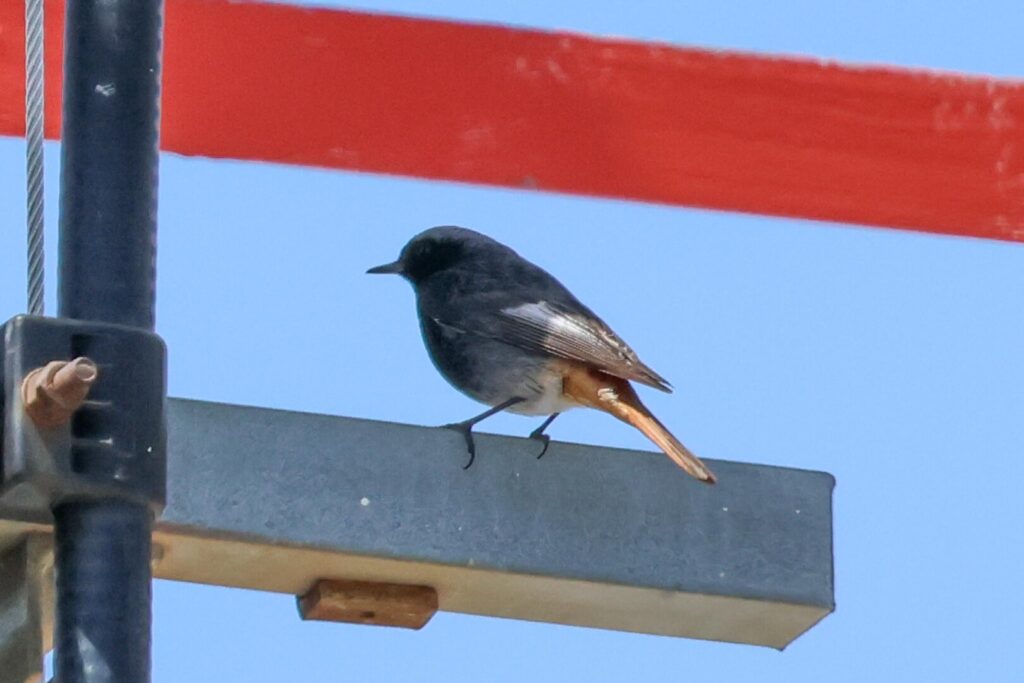
We could see the imposing rocky crags of Pico Villuercas towering up in front of us, so we drove round past Guadalupe and took the road up now, where several more Robins singing in the trees. The views from the top are spectacular, out over the surrounding countryside. A couple of Rock Buntings were flitting around on the crag above where we parked and a Wren was singing from the bushes below.
There were several Black Redstarts around the rocks, one male singing from the buildings and radio mast at the summit. Griffon Vultures were drifting past below us and a Peregrine appeared a couple of times briefly up from behind the crags. Several Queen of Spain fritillaries were fluttering around in the sunshine. This is a site for Rufous-tailed Rock Thrush, but we knew we were probably a couple of weeks too early for them here, unfortunately.
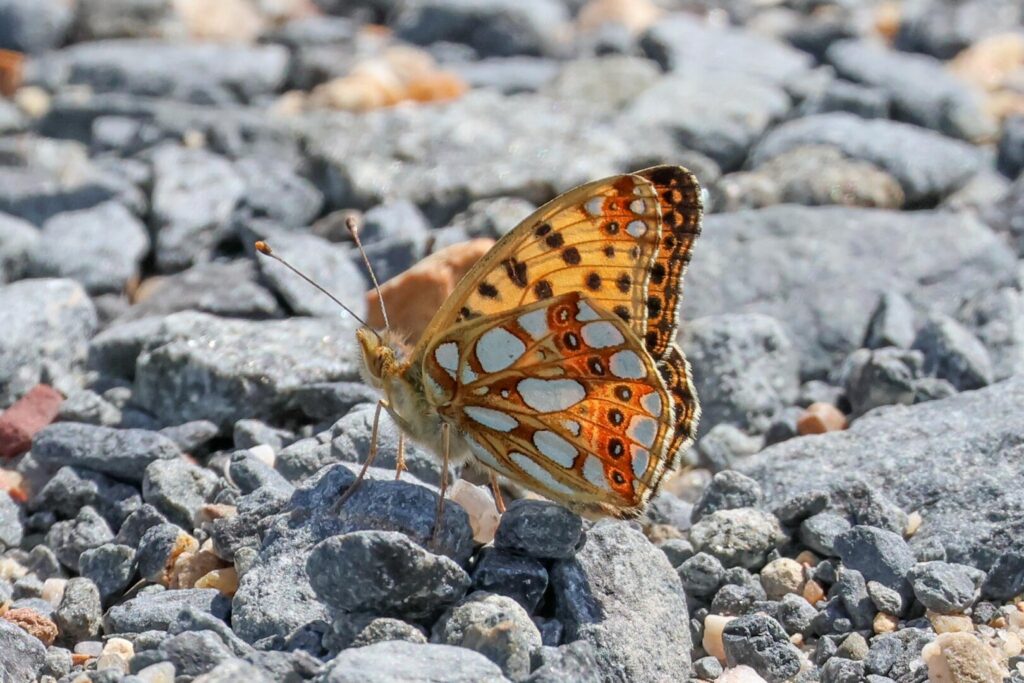
After admiring the views, we drove back down and continued on north, turning off again along the minor road to Hospital del Obispo. A Great Spotted Woodpecker was calling in the pines at the start of the road but there was nowhere to stop here and the ascent beyond was rather quiet until we got to a hairpin bend in the trees and saw some movement in the branches. We could pull off the tarmac onto the start of a track here, so we stopped and scanned and first found a Eurasian Jay. One of the group, in the back of the minibus, could see an Iberian Green Woodpecker climbing up one of the trunks further in but no one else could get on it from their angles and by the time we had all got out it had completely vanished. A couple of Robins were in the bushes below us, the first we had actually been able to see, and a Wren was singing too.
Continuing on to the top, we stopped at the mirador car park and walked down along the road through the trees. A Nuthatch was piping and some high pitched quiet calls in some dense undergrowth revealed themselves to be another Robin, but there were no more woodpeckers here. Scanning the crags beyond, there was a complete lack of any raptors too. We drove back down and took the scenic route round via Castanar de Ibor and Robledollano, scanning the rocky hills for raptors. There were more Griffon Vultures up now and we found at least one Black Vulture and a single Egyptian Vulture, but the only eagle we could locate today was a Booted Eagle.
We cut across to the motorway at Deleitosa, where we stopped to refuel and get an ice cream, and then took the quick route back to Pago de San Clemente for our last night.
Thursday 18th April
It was only starting to get light as we left early this morning, heading out onto the steppes before dawn on our last day. We could just see six Great Bustards out in the tall grass and we could hear at least three Little Bustards and several Common Quail calling. As we stood and listened to the Calandra Larks singing overhead and the Corn Buntings on the fence nearby, it was a beautiful sunrise, the skyline turning orange first before the sun appeared over the horizon.
Mist started to appear in the dips in the rolling ground, gradually increasing to fill them and spilling up over the ridges. We could just start to feel the heat in the sun so we knew it would only be a few minutes before it got warm enough to burn back the mist. A couple of Great-spotted Cuckoos flew across behind us and landed on the fence where we got them in the scope and we could hear Pin-tailed Sandgrouse calling.
As the mist cleared, we could see the Great Bustards again and another flew across and past us over the road. The grass was so high, it was hard to see the Little Bustards but we did eventually find one which we could see, on the ridge further back and watched it singing, throwing its head back. A pair of Black-bellied Sandgrouse flew past and another came over our heads, then a few Pin-tailed Sandgrouse flew past in front of us.
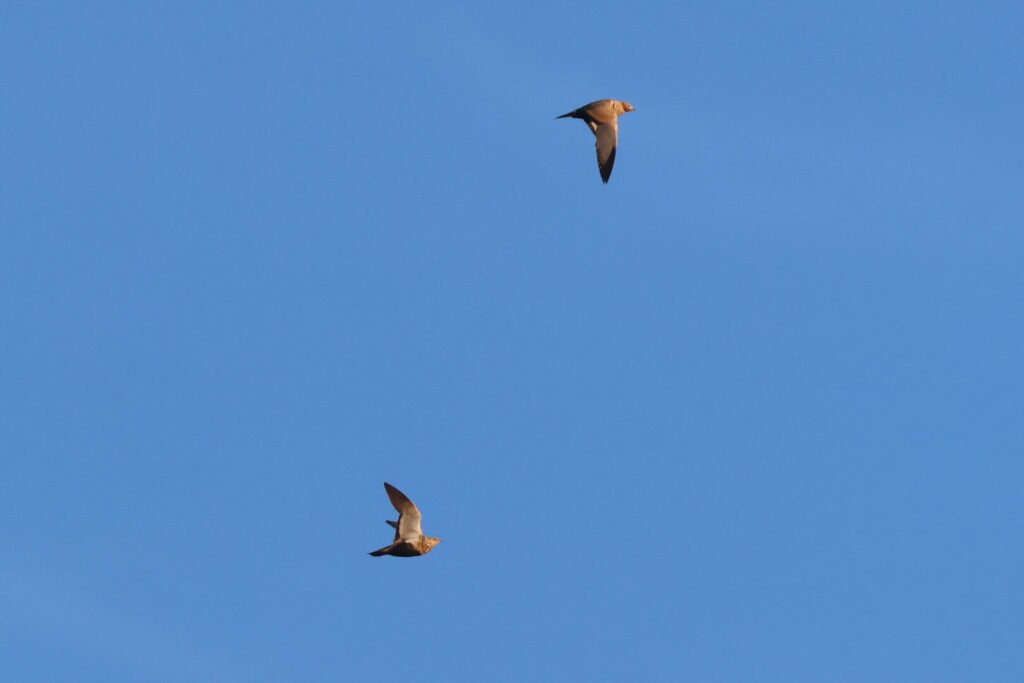
We had to tear ourselves away and drove back to the guest house for a late breakfast. On our way through Trujillo, there seemed to be more swifts around than there had been before but despite looking carefully we could only see Common Swifts still. After breakfast, we packed up, checked out, loaded up the minibus and said our goodbyes to Claudia. We didn’t have to be back in Madrid until this evening, so we still had most of the rest of the day in Extremadura.
We decided to do another circuit round first, revisiting some areas we had been to on our first day here, so we took the new road over towards Caceres and cut back in to the steppes. As we passed, we scanned the fields which had been cultivated earlier in the year where the vegetation was shorter – we found several Short-toed Larks and a single Great Bustard, quite close to the road but we had been spoilt by the one we had seen the other day.
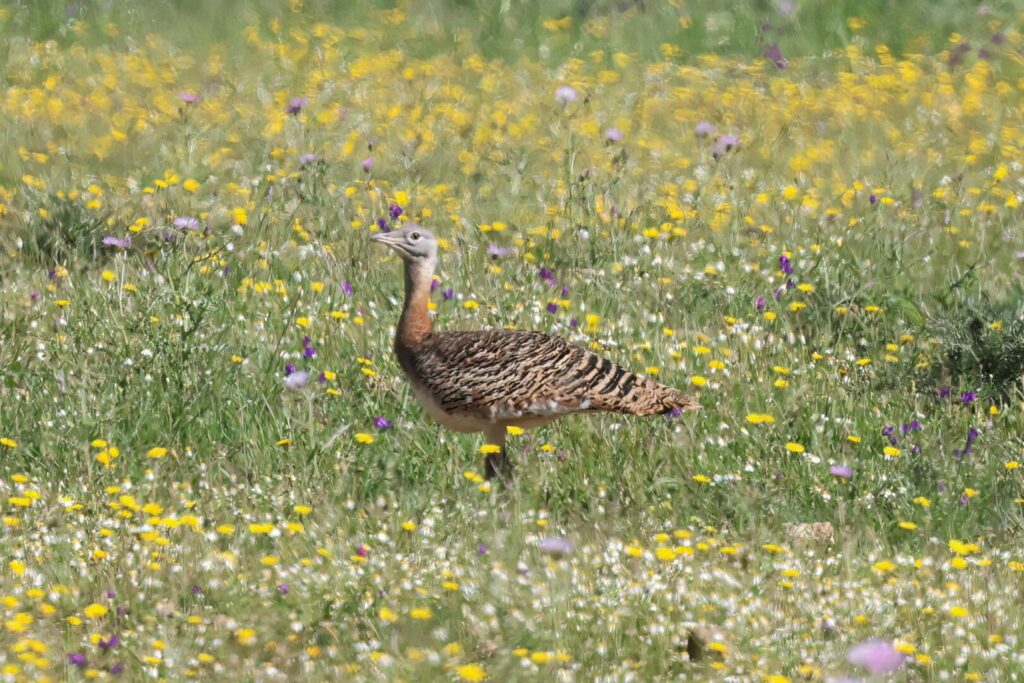
We stopped at the gate at the start of the drovers’ track and got out to see what we could find, quickly finding another three Great Bustards here, but more distant. A couple of Short-toed Larks kept flying out of the fields and landing on the road and a distant female Montagu’s Harrier circled up over the steppes.
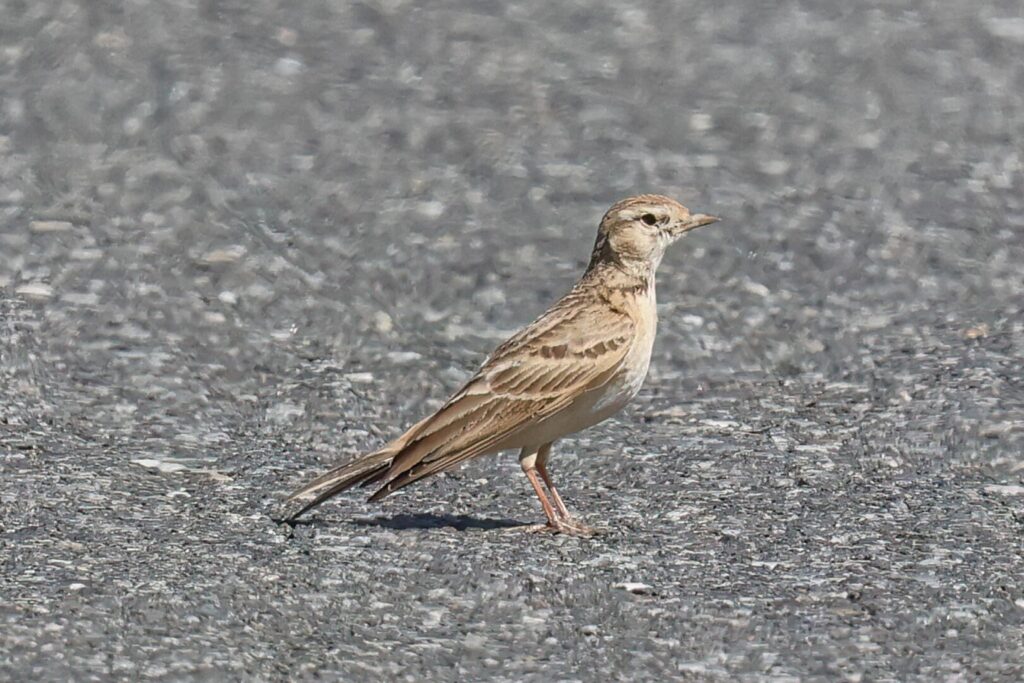
A Little Grebe on one of the small reservoirs was new for the trip list and a Red Fox appeared briefly on the dam. A Spanish Marbled White butterfly finally landed on some flowers long enough for us to get a proper look at it.
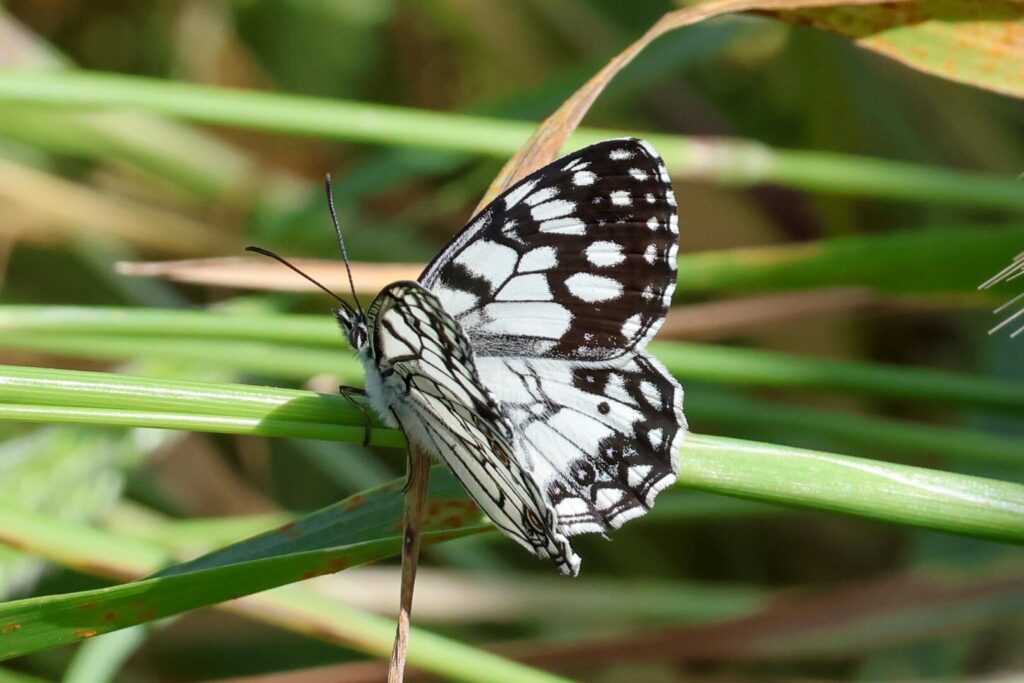
We carried on further along the road towards Santa Marta, stopping again briefly to admire a pair of Rollers on the wires.
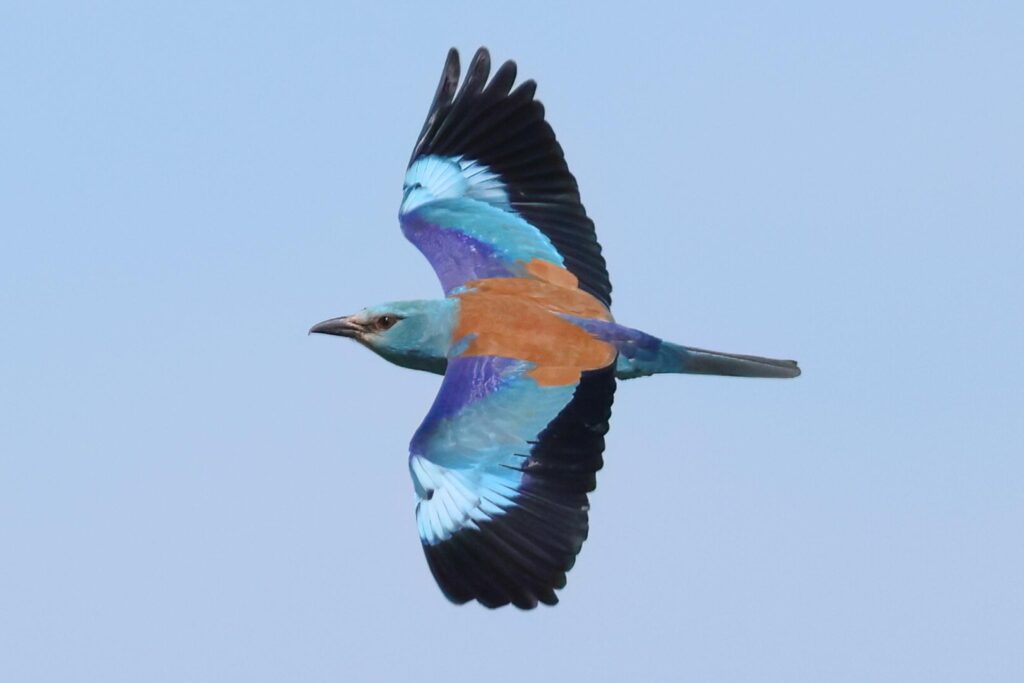
We were going to have another look at the Rio Tamuja crossing but there were several cars parked there already so we pressed on and stopped again at the Rio Magasca instead. The Crag Martins were not collecting mud today but were still flying in and out from under the bridge. The other side of the village, we noticed a large eagle circling with a kettle of vultures low beside the road and when we stopped to look at it we could see it was a young Spanish Imperial Eagle.
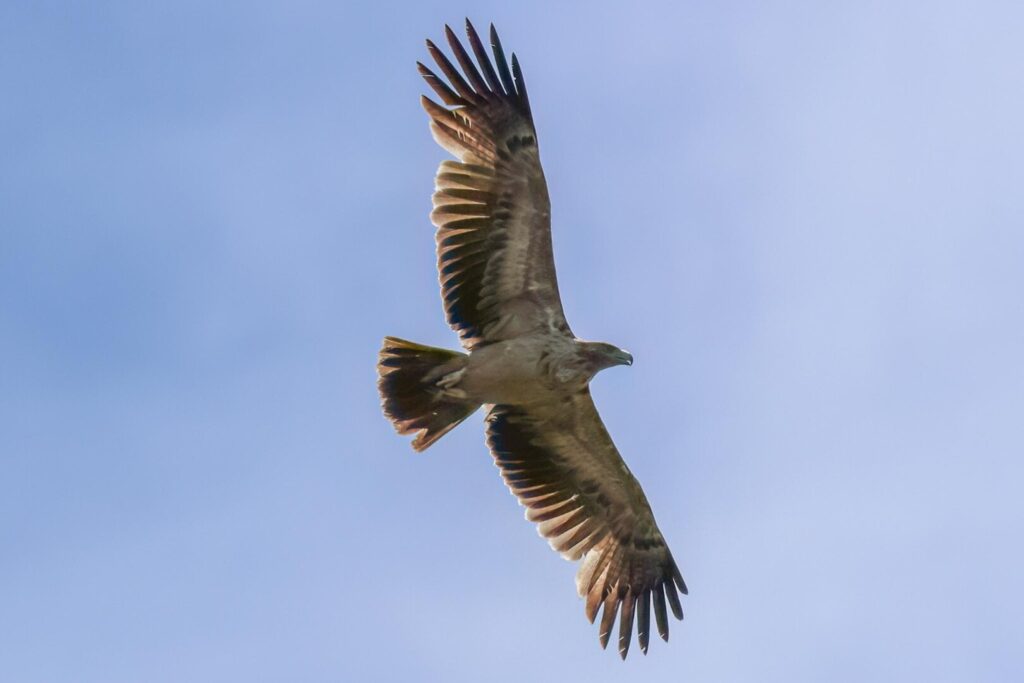
Only a short distance further on, we worked out where the vultures were coming from – there were lots on the ground, obviously there was something dead in the field just out of view, and we counted at least six Black Vultures in with a larger number of Griffons. A Western Orphean Warbler started singing on the other side of the road, but the leaves on the evergreen oaks were too thick to see it, although we did get flight views as it flew from tree to tree.
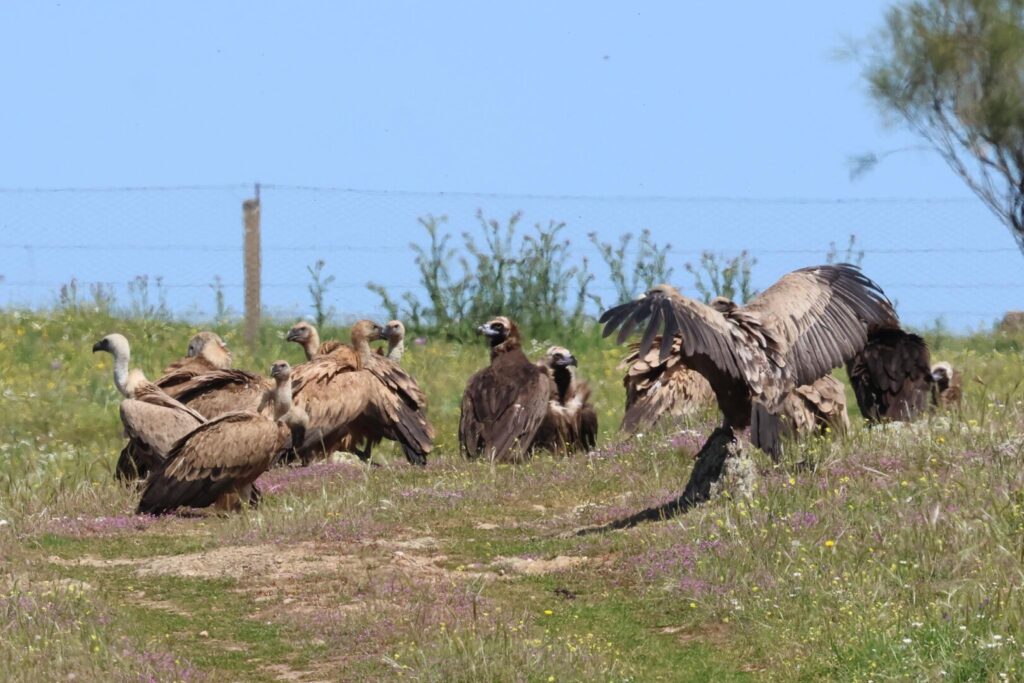
We stopped for lunch along the road to Monroy, at the Almonte bridge. The water levels are high here this year and there were not so many birds along the river, a few House Martins were in and out from under the bridge, a White Wagtail was singing along the shore and several Serins flew back and forth calling. After lunch, we drove up to Torrejon road and stopped in the shade of a stand of Stone Pines. There were several White Stork nests in the trees and a succession of Spanish Sparrows in and out from the nests. We had a quick walk down through the fields, which do not look to be cultivated this year and were coated in an amazing and very photogenic display of wild flowers.
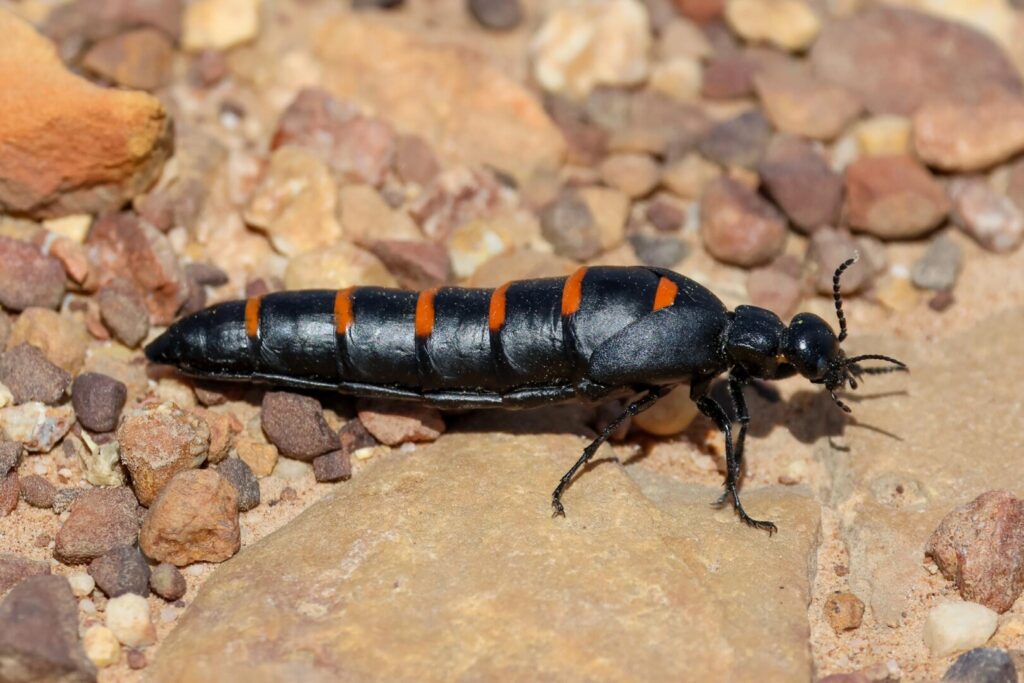
It was time to start making our way back towards Madrid, but we still had some stops to make on the way. We drove across to Jaraicejo and out onto an area of heath, where we parked and walked along a track. A Red-striped Oil Beetle ran across in front of us. It didn’t take long to locate our main target here, a male Spectacled Warbler which came up song-flighting ahead of us. We stood and watched and it perched up in the broom several times where we had some good views of it. On the way back to the minibus, a male Dartford Warbler was in the bushes too.
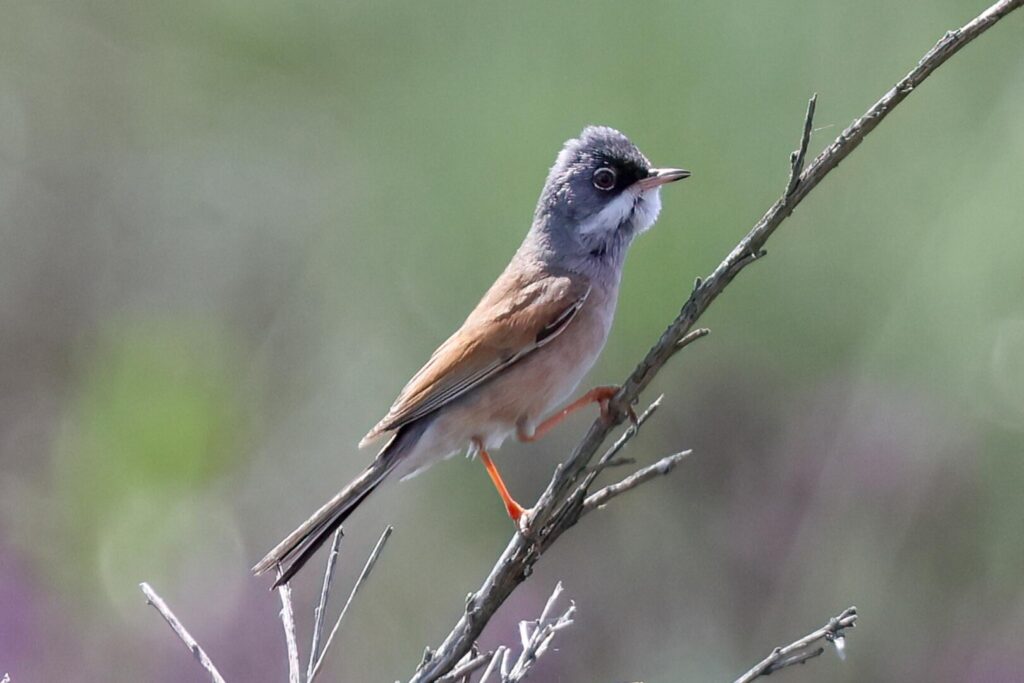
Back on the road, a shallow wet pool out in the fields held a group of fifteen Spoonbills and a couple of Egyptian Geese. We made our way back north on the motorway now and stopped again at Arrocampo. We only had time for a quick look around the first hide – a Sand Martin and two Red-rumped Swallows were hawking around with the Barn Swallows over the channel, two Cattle Egrets and a Little Egret flew past and a few Purple Herons flew back and forth over the reeds. We checked out the swifts over the church – all we could see initially were just a few Common Swifts still before they all disappeared, presumably flying off to feed.
It took a couple of hours to drive back to Madrid. On the way in to the city on the motorway, two Monk Parakeets flew across the road in front of us, a last addition to the trip list. We arrived in good time to drop off the minibus, finish packing away all our birding stuff into our bags and checked in. The plane left on schedule and arrived into Gatwick on time at 11.10pm. There was a big queue to get through immigration, there were even lots of people waiting at the e-gates, but that did mean our bags were waiting on the carousel when we got there. We said our goodbyes and headed off into the cold and drizzly London night.
